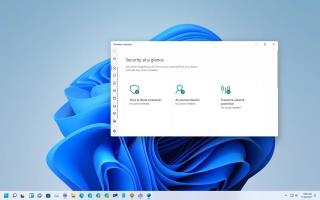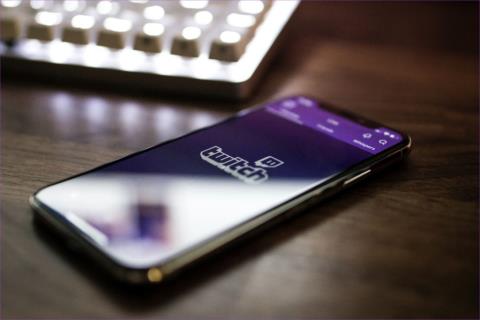Windows 11 recebe emojis 2D redesenhados

A atualização do Windows 11 KB5007262 traz novos emojis 2D em vez do estilo 3D originalmente prometido. Veja como obtê-los.

ATUALIZADO EM 05/01/2022: O Windows 11 (versão 21H2) foi lançado em 5 de outubro de 2021 e representa a próxima geração do Windows, que apresenta novos recursos e aprimoramentos para melhorar a segurança, a produtividade e modernizar toda a experiência.
Nesta versão, você encontrará mudanças significativas na interface do usuário para o menu Iniciar, Barra de Tarefas, Configurações e Explorador de Arquivos, incluindo cantos arredondados, fontes atualizadas e design consistente em todos os componentes.
Apesar de ser uma nova versão, ainda é baseada na tecnologia Windows 10, o que significa que mantém a mesma compatibilidade para aplicativos e drivers. No entanto, desta vez, o Windows 11 aumenta os requisitos do sistema, deixando muitos dispositivos sem chance de atualização.
Em 5 de outubro, a Microsoft começou a oferecer o Windows 11 como uma atualização gratuita para novos dispositivos que já executam o Windows 10 e que são conhecidos por terem uma experiência de atualização tranquila. Com o tempo, o sistema operacional se expandirá para mais computadores com base na elegibilidade do hardware, métricas de confiabilidade, idade do hardware e outros fatores. Então, em algum momento durante o segundo semestre de 2022, o Windows 11 estará totalmente disponível para dispositivos compatíveis.
Assim como nas versões anteriores, você receberá uma notificação para baixar a nova versão manualmente por meio do Windows Update. Se você é um “buscador”, pode forçar a atualização clicando no botão Verificar atualizações nas configurações do Windows Update e, em seguida, no botão Baixar e instalar . Como alternativa, você também pode instalar a nova atualização usando a Ferramenta de criação de mídia para realizar uma atualização in-loco ou uma instalação limpa . Além disso, você pode usar o Installation Assistant ou até mesmo baixar o arquivo ISO para criar uma mídia inicializável USB que você pode usar para atualizar.
O que há de novo no Windows 11
Aqui estão todos os novos recursos do Windows 11 disponíveis, desde o menu Iniciar redesenhado até a Barra de Tarefas centralizada, a experiência da Central de Ações, os novos Widgets, Áreas de Trabalho, Explorador de Arquivos, aplicativo Configurações revisado, melhorias ocultas e muito mais.
Novo menu Iniciar do Windows 11
O Windows 11 vem com um menu Iniciar redesenhado que abandona os Live Tiles em favor de ícones tradicionais e um novo design minimalista. O menu é baseado no design da empresa para o Windows 10X. Ele flutua acima da barra de tarefas e segue o novo design no estilo do sistema operacional com cantos arredondados e materiais semitransparentes.
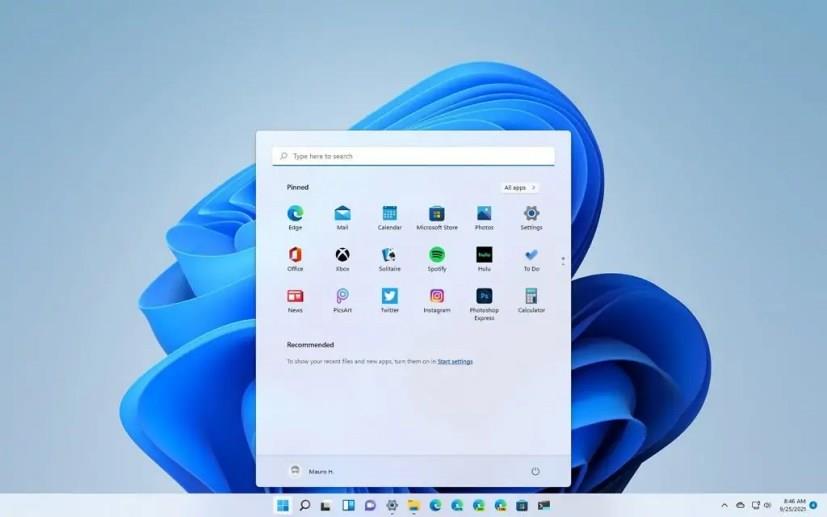
Menu Iniciar do Windows 11
O menu é dividido em quatro seções. A parte superior inclui uma caixa de pesquisa que alterna para a experiência do Windows Search assim que clica, que é semelhante à do Windows 10 , mas com pequenos ajustes.
A seção Fixado inclui todos os seus aplicativos favoritos e apresenta várias páginas à medida que você adiciona mais aplicativos. No canto superior direito, você encontrará um botão para acessar a lista “Todos os aplicativos” que funciona como a lista no Windows 10.
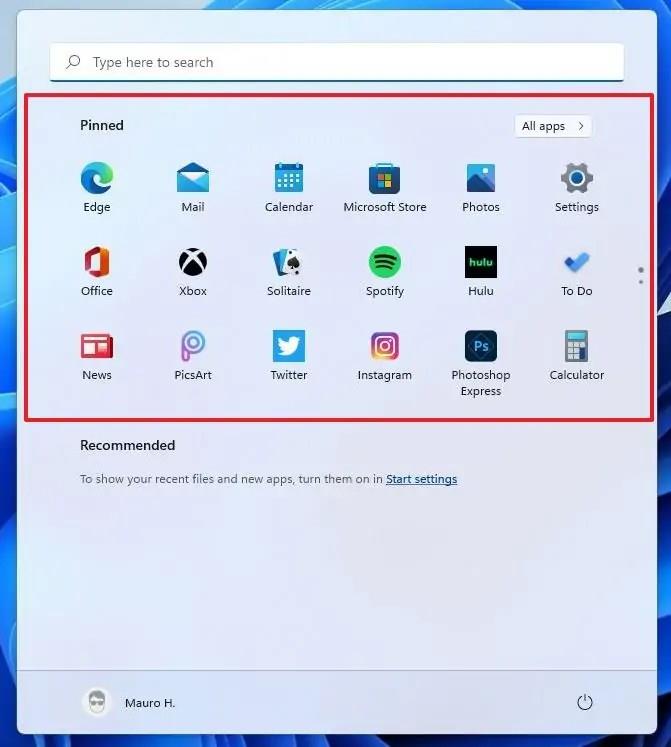
Menu Iniciar fixado
O menu Iniciar agora inclui uma seção Recomendado que funciona como “Linha do tempo”, mostrando os itens mais usados, incluindo documentos e locais de pastas.
Por fim, na parte inferior, você encontrará o menu de perfil que inclui as opções para alterar as configurações da conta, bloquear, sair e trocar de usuário. À direita, é onde está localizado o menu de energia, mas as opções serão diferentes dependendo das capacidades do dispositivo. No espaço restante, é onde você pode colocar acesso rápido a pastas, incluindo Documentos, Downloads, Configurações, etc.
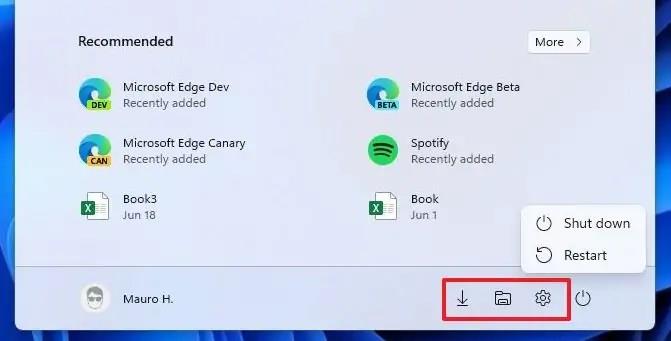
Itens de pasta
A partir do Windows 11, o menu Iniciar vem alinhado ao centro da tela, mas você pode alinhá-lo à esquerda usando o aplicativo Configurações.

Barra de tarefas alinhada centralizada e à esquerda
Você também pode personalizar vários aspectos da experiência no menu para facilitar a localização e o lançamento de aplicativos. Por exemplo, você ainda pode clicar com o botão direito do mouse no aplicativo para disponibilizá-lo na seção "Fixado".

Iniciar menu de contexto
Você pode arrastar e soltar os itens na posição desejada, mesmo em uma página diferente. Ou você pode clicar com o botão direito do mouse no item e selecionar a opção “Mover para o topo”. Além disso, é possível desafixar o aplicativo do Iniciar ou da Barra de Tarefas no menu de contexto.
Se você precisar remover o aplicativo, o menu de contexto incluirá uma opção para desinstalá-lo com um novo design de diálogo.
Como há várias páginas na seção “Pinned”, você pode usar a roda do mouse para rolar ou usar os pontos no lado direito.
A seção Recomendado mostra o aplicativo instalado mais recente, aplicativos usados com frequência e arquivos abertos recentemente. Você pode decidir o que aparece nesta seção do menu na página de configurações Iniciar. Ou você sempre pode clicar com o botão direito do mouse em um item e selecionar a opção para removê-lo da lista. Se o sistema tiver mais recomendações, você verá o botão Mais para ver uma lista com todos os arquivos e aplicativos que estava usando recentemente.
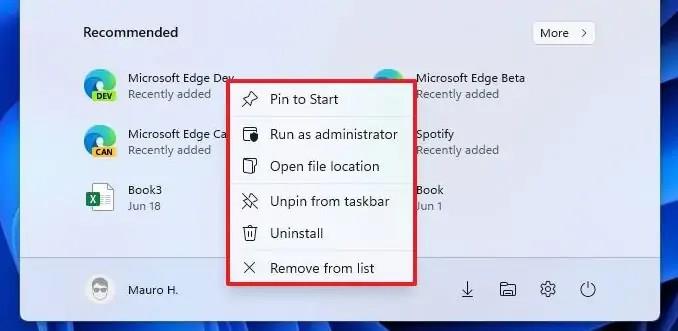
Remover item recomendado
Embora você possa remover itens nesta seção , se você tentar limpar todos os itens, a área aparecerá vazia em vez de expandir a seção "Afixados" para ver mais aplicativos fixados.
Se um item estiver fixado em Iniciar, mas não estiver instalado, semelhante ao menu clássico, quando você clicar nele, uma barra de carregamento aparecerá até que o aplicativo seja instalado na Microsoft Store.
Embora haja muitas coisas boas sobre o novo Start, o menu carece de muitos recursos e flexibilidades da experiência clássica. Por exemplo, uma das mudanças mais significativas com o novo design é que os Live Tiles não estão mais disponíveis. Como resultado, a opção de alterar o tamanho também desapareceu.
Você não tem mais a opção de usar o menu Iniciar em tela cheia. Você não pode redimensionar o menu com o mouse, nem há uma opção para alterar o tamanho no aplicativo Configurações. A capacidade de agrupar aplicativos em pastas desapareceu e, por padrão, ele vem com vários aplicativos semelhantes a anúncios, difíceis de distinguir dos aplicativos instalados.
Além disso, na lista “Todos os aplicativos”, a pasta “Ferramentas Administrativas do Windows” foi substituída pela opção “Ferramentas do Windows” que abre a página Ferramentas do Windows no Painel de Controle. A página combina todas as opções disponíveis nas pastas Ferramentas Administrativas do Windows, Acessórios do Windows, Windows PowerShell e Sistema do Windows.
Nova barra de tarefas
Embora possa parecer semelhante, a barra de tarefas é nova. A primeira coisa que você notará é que a barra de tarefas agora está alinhada ao centro da tela. A experiência redesenhada também inclui um novo botão Iniciar e novos botões para acessar vários recursos, incluindo Pesquisa, Visualização de Tarefas, Widgets e Bate-papo.

Botões da barra de tarefas do Windows 11
Você não pode remover os botões da barra de tarefas, mas pode ocultá-los na página de configurações da barra de tarefas.
Além do novo design, a Barra de Tarefas possui novas animações para muitas ações, inclusive ao instalar, maximizar, minimizar e iniciar um aplicativo. E há uma nova animação de salto para aplicativos à medida que a conta é carregada durante a inicialização. Sob o botão do aplicativo, você verá agora um indicador em forma de pílula que altera o tamanho dos aplicativos em execução para indicar onde eles são minimizados ou maximizados.
No Windows 11, a Barra de Tarefas tem mudanças excelentes e não tão boas. Por exemplo, a experiência agora está alinhada ao centro por padrão, mas é possível alterar o alinhamento à esquerda modificando as configurações.
A interface é um pouco mais alta do que antes, e elementos como dicas de ferramentas, visualizações, menu flutuante e botões que passam o mouse agora seguem o novo estilo de design com cantos arredondados e materiais.
Se um aplicativo requer atenção, o piscar será mais sutil, ele irá parar, e há uma nova placa traseira com uma cor vermelha clara e ícone de pílula vermelha informando que o aplicativo requer atenção.
Grupos de snap
O Windows 11 também inclui novas melhorias de multitarefa, incluindo "grupos de snap", que é um recurso que permite que você passe o mouse sobre um aplicativo que pertence a um conjunto de janelas encaixadas na tela para alternar para o grupo ajustado sem precisar reencaixar rapidamente. Esse recurso é útil quando você está trabalhando com várias janelas e, de repente, alterna para outro aplicativo e deseja retornar ao grupo de janelas ajustadas.

Grupos de snap
Além disso, a Barra de Tarefas não inclui mais uma caixa de pesquisa. Em vez disso, você encontrará um botão Pesquisar para abrir a experiência do Windows Search, que permanece a mesma disponível no Windows 10.
Bandeja do sistema redesenhada
A Barra de Tarefas também possui uma bandeja do sistema redesenhada que agrupa ícones relacionados em um único botão para abrir o novo “Centro de Notificações” e “Configurações Rápidas”. Por exemplo, clicar no grupo que inclui os ícones de rede, volume e bateria abrirá o submenu Configurações rápidas.
E clicar nos ícones de hora e data e notificações abrirá o submenu da Central de Notificações.

Bandeja do sistema
Você também pode clicar com o botão direito do mouse em cada item para abrir seu menu de contexto para acessar as diferentes opções disponíveis.
O menu de contexto principal da barra de tarefas foi removido do Windows 11 e substituído por uma única opção para abrir a página de configurações da barra de tarefas, onde você pode configurar vários aspectos da experiência.

Menu de contexto da barra de tarefas
Você pode mostrar ou ocultar botões na página de configurações, controlar os ícones que aparecem na bandeja do sistema e no overflow dos cantos, alterar o alinhamento da barra de tarefas e ativar ou desativar o ocultamento automático da barra de tarefas. E há até uma opção para ocultar o botão de exibição da área de trabalho.
Problemas de design
Ao tentar simplificar a experiência, parece que a Microsoft está tornando a barra de tarefas menos flexível. Por exemplo, a interface agora está bloqueada na parte inferior e você não pode movê-la para o lado superior, esquerdo ou direito da tela. (Se você deseja realocar a barra de tarefas, você precisa usar uma solução alternativa .)
Você não pode mais soltar aplicativos ou arquivos para fixar os itens na barra de tarefas.
A capacidade de mostrar rótulos para aplicativos desapareceu e agora você fica apenas com a visualização de ícones.
Não é mais possível alterar o tamanho dos ícones, nem a altura da Barra de Tarefas.
A opção de ocultar a data e a hora desapareceu e abrir a Central de Notificações não mostrará mais a hora com segundos. Além disso, a hora só aparecerá na tela principal.
Finalmente, você não pode mais ocultar os ícones do sistema da bandeja do sistema, como rede, volume, energia, etc.
Nova Central de Notificações e Configurações Rápidas
A Central de Ações não existe mais no Windows 11. Em vez disso, agora você tem duas novas experiências, incluindo “Central de Notificações” e “Configurações Rápidas”.
Centro de Notificação
Clicar no grupo de ícones com hora e data e notificações ou usar o atalho de teclado tecla Windows + N abrirá a Central de Notificações .
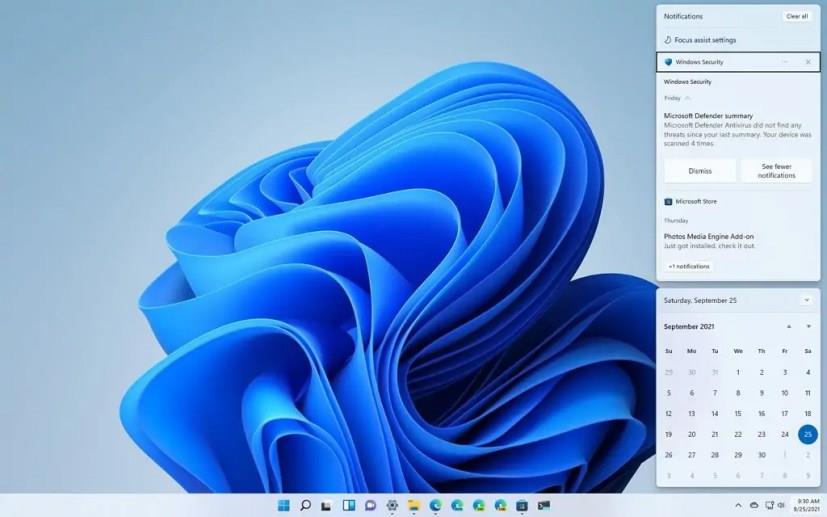
Centro de Notificação
A interface apresenta dois grupos empilhados que usam o novo design de estilo com cantos arredondados e materiais semitransparentes.
Na parte superior, é onde você encontra todas as suas notificações. A interface pode parecer diferente, mas funciona da mesma forma que a experiência encontrada no Windows 10. Se você tiver mais de uma notificação do mesmo aplicativo, o sistema mostrará apenas a mais recente, ocultará a redefinição e informará o número de mensagens que você não viu.
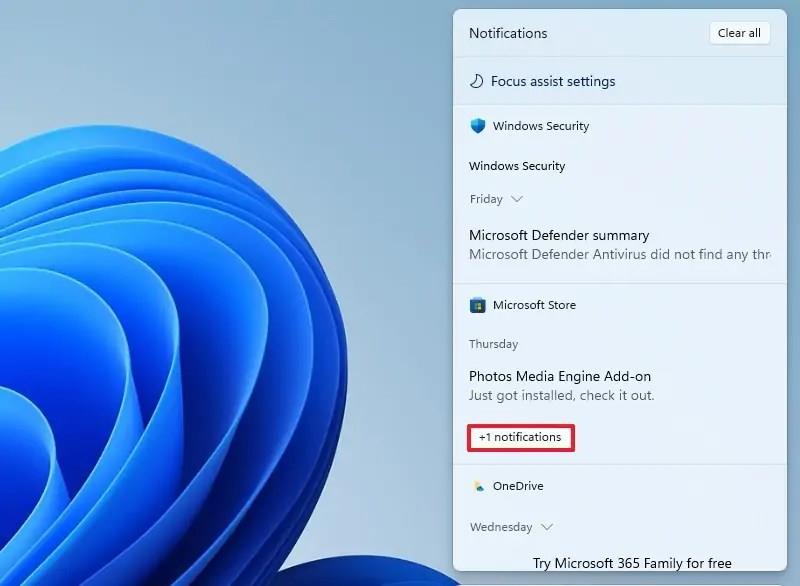
Lista de notificações
Na parte inferior, você encontrará o calendário com a data atual na parte superior, mas sem a hora. Ao contrário do calendário nas versões anteriores, este não mostrará os próximos eventos, nem você poderá criar novos eventos diretamente desta interface.
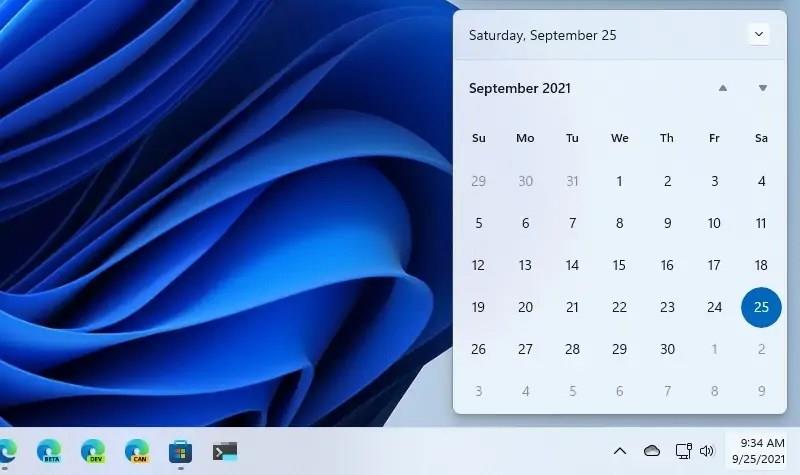
Submenu do calendário
Se precisar acessar as configurações de notificação, você sempre pode clicar com o botão direito do mouse no ícone de notificação e escolher a opção Configurações de notificações . Ou você pode clicar na opção de configurações do assistente de foco na parte superior.
Configurações rápidas
No Windows 11, você pode abrir as Configurações rápidas clicando no grupo de ícones de rede, volume e energia ou usando a tecla Windows + Um atalho de teclado.
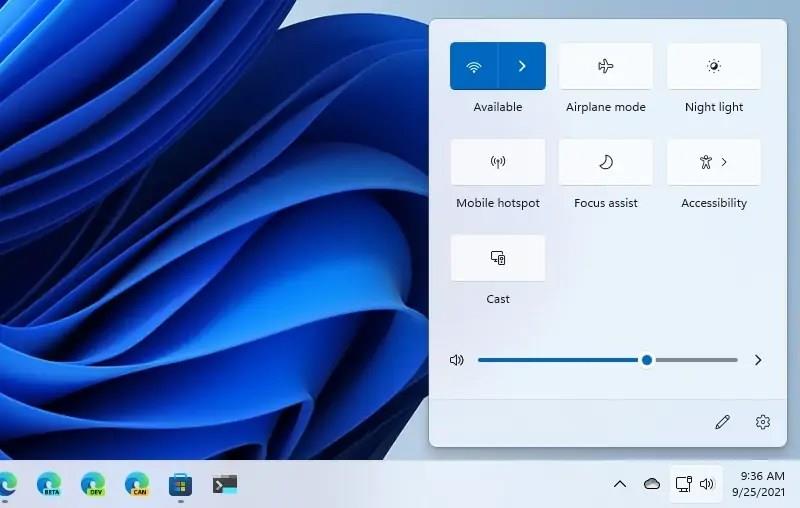
Configurações rápidas
O submenu permite controlar configurações rápidas como Wi-Fi, Bluetooth, Modo avião, Economia de bateria, Assistente de foco, Acessibilidade, Luz noturna, Transmissão, Layout do teclado, Ponto de acesso móvel, Compartilhamento de proximidade e Projeto. Além disso, dependendo do recurso, você pode abrir um submenu com a opção de controlar ainda mais a experiência. Por exemplo, clicar no botão ao lado de Acessibilidade permitirá que você ative ou desative a Lupa, Filtros de cores, Narrador, Áudio mono e Teclas adesivas.
Se o recurso estiver disponível, você também poderá controlar o brilho e ajustar o volume do sistema.
Na interface, você também encontra o nível da bateria, opção de editar os itens que deseja ver no layout e acesso rápido ao app Configurações.
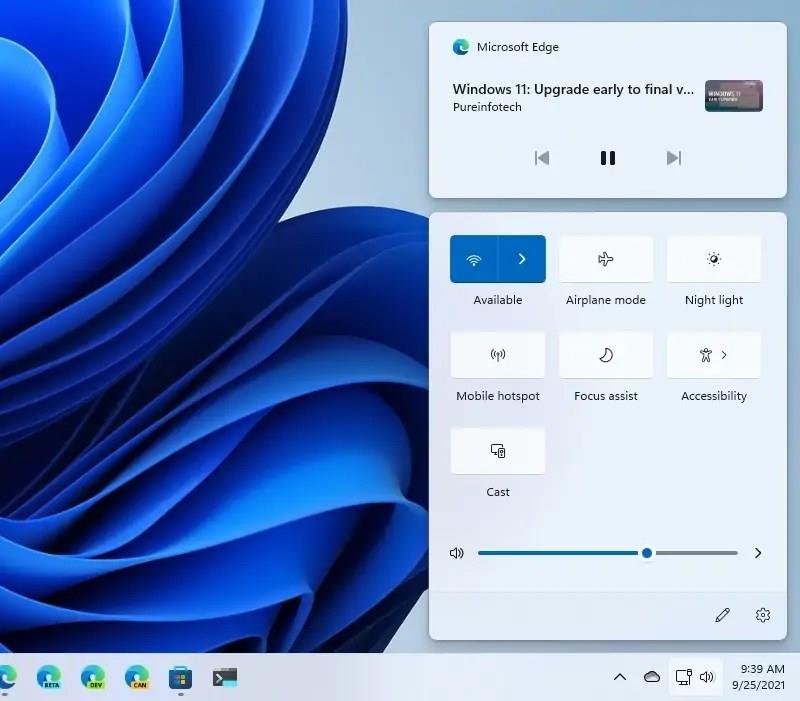
Controles de mídia de configurações rápidas
No Windows 11, acima dos submenus Configurações rápidas, você também encontrará controles de mídia ao reproduzir vídeos no Google Chrome, Microsoft Edge ou aplicativos de mídia compatíveis.
Recurso de widgets do Windows 11
O Windows 11 inclui um recurso chamado “Widgets”, uma nova interface que desliza do lado esquerdo da tela para fornecer diferentes tipos de informações, como previsão do tempo, notícias, rastreamento, esportes, entretenimento e muito mais.
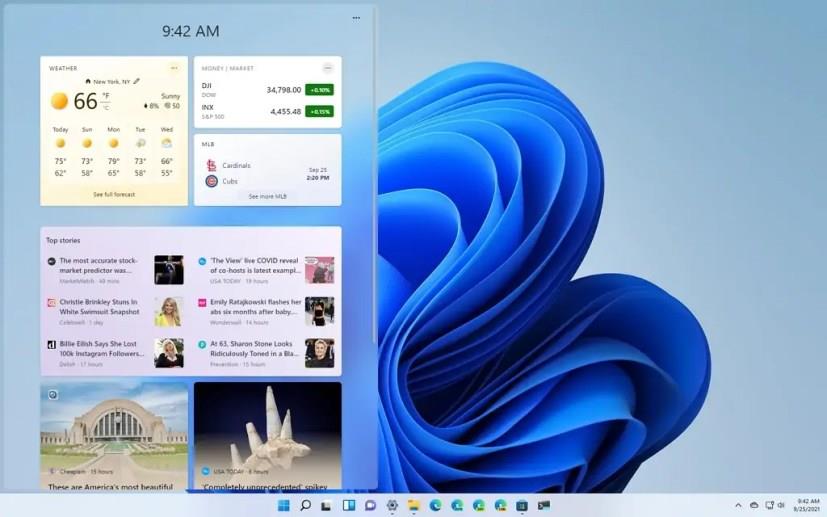
Widgets do Windows 11
Se esta experiência parece familiar, é porque esta é a evolução das “notícias e interesses” disponíveis no Windows 10 .
Você pode abrir Widgets com o botão dedicado na barra de tarefas ou usando a tecla Windows + atalho de teclado W. Em dispositivos habilitados para toque, você pode deslizar da borda esquerda para abrir a experiência.
A interface ocupa uma seção da tela e inclui a hora, a caixa de pesquisa (alimentada pelo Bing e Edge) e, em seguida, você obtém duas áreas, a que mostra seus widgets com coisas pessoais e o feed personalizado.
Na seção pessoal, você pode ter widgets para ver o clima, acompanhar suas listas de tarefas da Microsoft, obter informações de trânsito, calendário do Outlook, esportes e muito mais.
A única ressalva é que você encontrará apenas widgets criados pela Microsoft.
Você sempre pode adicionar ou remover widgets clicando no botão Configurações no canto superior direito e selecionando os itens que deseja ver.
Depois, há a seção de notícias alimentada por IA e personalizada com base em seus gostos. Você não pode reorganizar os cartões, mas pode ocultar, curtir e salvar para mais tarde clicando no botão de menu no canto inferior direito. Se você não gostar de uma história, clique no botão "Ocultar esta história" no canto superior direito para removê-la.
Embora não seja possível alterar muitas configurações dos widgets de notícias, você pode abrir as configurações de Widgets e personalizar seu Feed de notícias para configurar os interesses.
Como esse é um recurso baseado em nuvem, ele só funcionará quando conectado com uma conta da Microsoft. Se você sair, a interface de Widgets aparecerá vazia.
Melhorias na área de trabalho do Windows 11
No Windows 11, “Desktops” é o que antes era conhecido como “Desktops Virtuais” e é um recurso que permite criar vários desktops virtuais para separar diferentes trabalhos, como jogos, escola e trabalho.
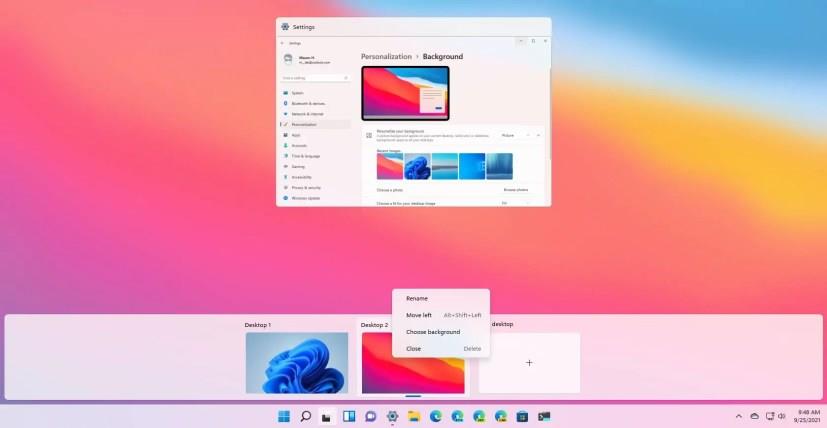
Áreas de trabalho do Windows 11
O recurso funciona praticamente da mesma forma que antes, mas a experiência foi redesenhada. Por exemplo, quando você clica no botão Exibição de Tarefas na Barra de Tarefas ou usa o atalho de teclado tecla Windows + Tab , você descobrirá que as Áreas de Trabalho agora estão disponíveis na parte inferior da tela. Como antes, você continuará vendo uma lista de aplicativos em execução, mas a Linha do tempo não estará mais disponível desde que foi removida.
Assim como o restante da experiência do sistema, a interface segue o mesmo novo estilo do Windows 11 projetado com cantos arredondados e materiais semitransparentes.
On Desktops, you can reorganize, create, and customize as many virtual desktops as you need, and each one can have a different background to differentiate each space better.
To change the background image, right-click the desktop and select the Choose background option to open the “Background” settings and choose another image file.
The context menu for Desktops also includes options to change the position of the desktop to left or right.
New Snap layouts and Snap groups
As part of the “Snap assist” feature, Windows 11 is introducing two new improvements, including “Snap layouts” and “Snap groups,” to make it easier to organize and work with multiple windows on the screen.
Snap layouts
“Snap layouts” is a feature that, when hovering over the maximize button in File Explorer or other apps, gives you a visual aid to snap windows on the screen using different grids quickly.

Windows 11 Snap layouts
On smaller screens, you will see a set of four snap layouts or six layouts on larger screens. You can also open the snap layouts flyout with the Windows key + Z keyboard shortcut.
While in portrait mode, when snapping windows to the right and left, Snap assist will now position one window at the top and the other at the bottom.
Snap groups
“Snap groups” is a way to switch back quickly to your group of snapped windows when switching to a different app. For example, you can snap together at least two apps. Then if you suddenly switch to another app, you can hover over one of these open apps in the Taskbar to find the snap group and click to switch back.

Snap groups
New Voice Typing app
Windows 11 also has a new Voice Typing app to help you type with your voice. It’s off by default, but you can open it from the voice typing settings or with the Windows key + H keyboard shortcut.

Voice Typing app
The new app has a modern interface and is straightforward. It includes a microphone button to begin typing. And the settings menu lets you customize some options, including the ability to enable an option to launch the experience faster and use auto punctuation.
New Windows 11 File Explorer app
This new version of Windows comes with an updated File Explorer experience. However, it’s not an entirely new application. Instead, this is the same app but with an updated interface.

Windows 11 File Explorer
The design was done using the Windows UI Library (WinUI) that includes new visual elements, animations, and controls that match the style Microsoft is pushing on Windows 11.
Command bar
The new File Explorer ditches the ribbon-style menu in favor of a new minimalist header that combines the title bar and menu into a unified interface that includes the new command bar.
The command bar includes all the new commands to perform the different actions, including Cut, Copy, Paste, Rename, Share, and Delete. And this time around, the icons no longer have labels, which means that you will have to rely on their shape to know the action you want to take.
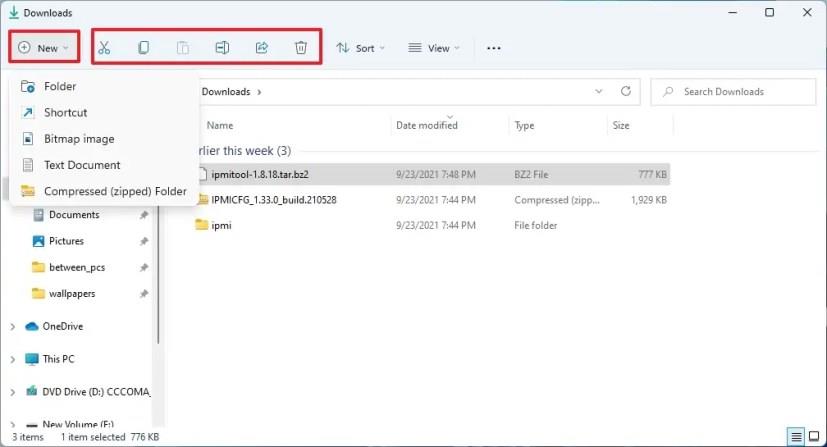
File Explorer command bar
You will also notice the “New” menu that includes all the standard options to create new folders, shortcuts, or documents, which means that you no longer have a dedicated option to create folders. However, you can still use the “Ctrl + Shift + N” keyboard shortcut to create a new folder quickly.
The command bar also includes three new menus, including “Sort and group options,” “Layout and view options,” and “See more.”
The Sort menu houses the options to sort content by name, date modified, type, and more.
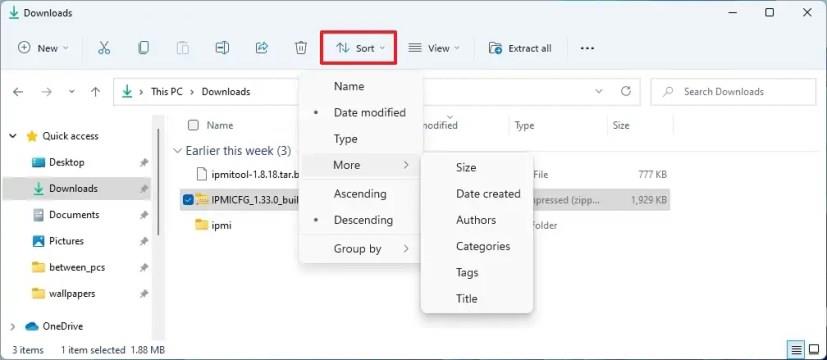
Sort menu
The View menu can show files and folders with different sizes like extra-large, large, small, list, details, tiles, and content. The option to enable the compact view is also located here. The menu also includes the Show submenu that has the options to manage the left pane view, show extensions, or show hidden items.

View menu
Then, the three-dotted is the See more menu that includes the options for selections, compressed to ZIP file, and Options to manage the app settings.
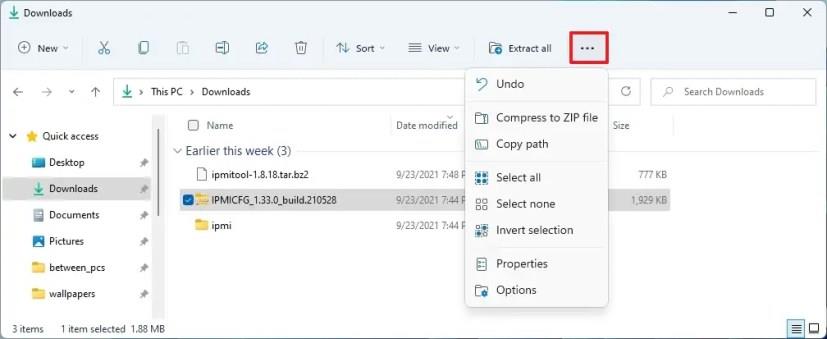
See more menu
These menus will also show different commands depending on your viewing content. For instance, if you are on the “This PC” page, the “See more” menu will also include the options to mount a network drive, but the “New” menu will be grayed out.
Also, if you select a media file like a picture, you will get additional commands like in the legacy version of the app.
Context menu
File Explorer for Windows 11 also introduces a new context menu style. You will see this menu when right-clicking a file or folder. The context menu includes a row with common commands like Cut, Copy, Rename, Share, and Delete, and below, you will find the options you can use with that specific file.
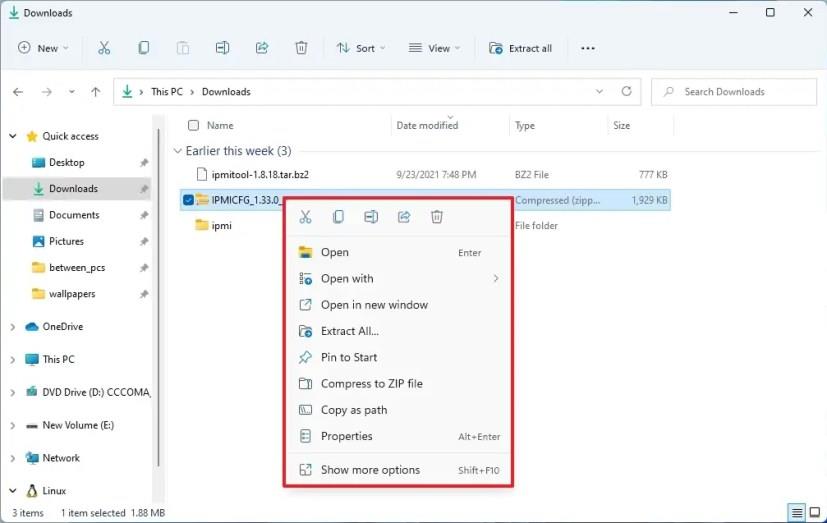
File Explorer context menu
Similar to other elements across Windows 11, the context menu follows the new design language with semi-transparent materials and rounded corners. The legacy menu is still available if you need some of the old options that are not available in the new menu. You can access the legacy view by clicking the Show more options or using the Shift + F10 keyboard shortcut.
The new context menu is also available throughout Windows 11, including for the Desktop context menu.
Scrollbar
File Explorer has a new scrollbar that works the same as before, but it has a thinner design. In the left pane, you will also find a new Linux option. This entry has been designed to give you quick access to Linux files inside distros installed with the Windows Subsystem for Linux.
Share
In this new version, the “Share” interface is getting an update. On Windows 11, when you click the Share button, you will get a new UI with several improvements. For example, you will now see a preview of the items along with the option to enable “Nearby sharing” if it’s not enabled. If the contact you want to send the file or the app is not in the list, you now have an option to select a different app or look up your contacts.

Share UI
New icon
Alongside the new interface, File Explorer also introduces new default icons with new styles, orientations, and colors.

File Explorer new icons
Windows 11 includes new icons for pretty much every element in File Explorer, but the ones you will notice immediately are for the default folders (Desktop, Documents, Downloads, Music, and Pictures). There are three versions for the default folder icon. One shows when the folder is empty, another one slightly different that indicates that folder has files, and you will even find an updated version of the zip folder icon.
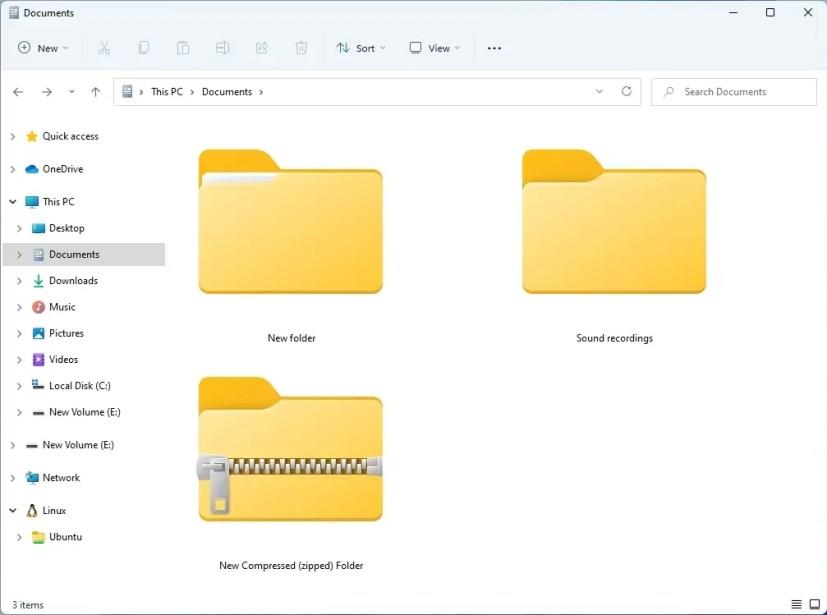
New folder icons
Microsoft has also made icons for other elements like the installation drive, secondary and network storage, This PC, Network, and there are new icons in the “Folder Options” settings.
While the new File Explorer includes many new visual changes, a lot of elements remain virtually unchanged. You will see this when changing settings, using the Format tool, or when trying to mount a network folder.
Other changes with File Explorer for Windows 11 include the “Run with PowerShell” option in the context menu for PowerShell scripts. You will now be able to extract all files from a zip folder that was previously set to online-only content in OneDrive. And when remaining content, it’s now possible to use the CTRL + Delete and CTRL + Backspace to delete words at a time and the CTRL + Left and Right arrow to move the cursor between words within the name.
Clipboard changes and features
Windows 11 introduces a new version of its Emoji Picker that integrates with the clipboard history and supports animated GIFs. This is, in addition, to support for additional languages, kaomoji, and symbols.
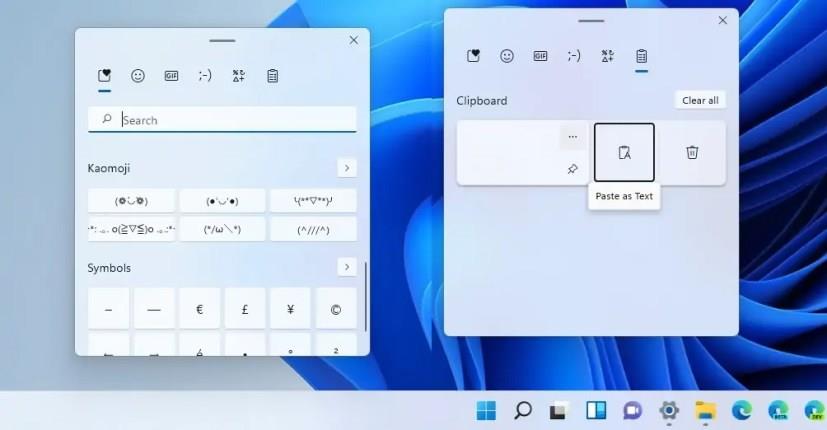
Windows 11 Clipboard UI
The new interface has a modern design using Fluent Design visual elements, such as blur and transparency, and it includes an inline search box to make it easier to discover emojis and animated GIFs.
Since the Emoji Picker is integrating the clipboard history interface, you can now insert emojis and copies from a single experience using the “Windows key + .” or “Windows key +;” or “Windows key + V” keyboard shortcuts.
Starting with this version, you will also find support for Emoji versions 12.1 and 13.0, which brings over 200 new glyphs, and now there are gender-neutral emoji designs.
Furthermore, the clipboard history interface includes options to pin, unpin, delete, paste as text, and individual sync entries.
Finally, if you use the Snipping Tool, when you use the Windows key + Shift + S keyboard shortcut, the capture will now be stored in the Clipboard to paste it on any folder to save the screenshot as a .png file.
Task Manager improvements
As part of the Task Manager improvements, Windows 11 now classifies and shows all the processes from Microsoft Edge. The classification is divided into several elements: Tabs, Browser processes (Browser, GPU Process, Crashpad), Utility plugins (Utility: Audio Service Extensions), and Dedicated & Service workers, and more.
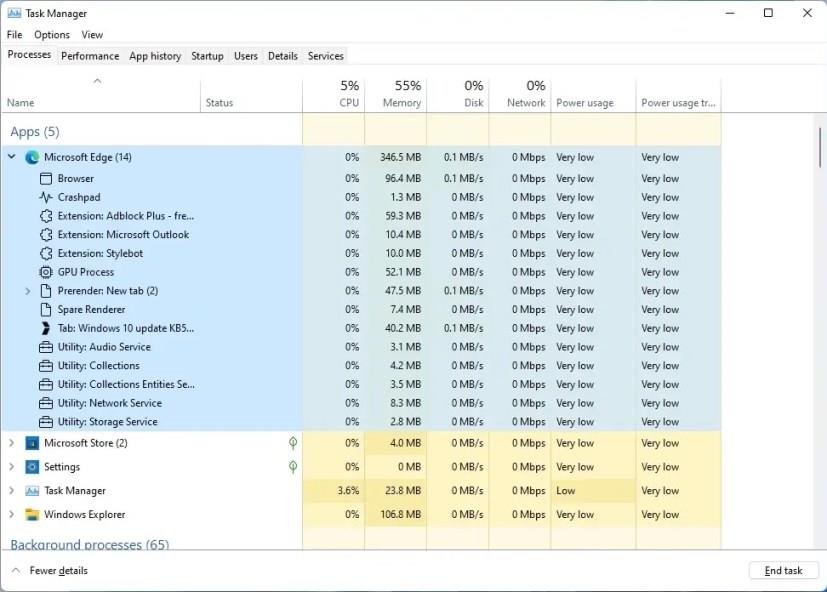
Task Manager Edge classification
You will also see that each process classification is described with an icon to make it easier to identify. If you are viewing a website tab in the processes, it will include the site icon.
Auto-HDR for gaming and DirectStorage
Windows 11 also comes with “Auto HDR for games,” a new feature that has been designed to improve the gaming experience by automatically converting compatible titles from standard-dynamic-range (SDR) to high-dynamic-range (HDR) to unlock the brighter and bolder colors available on compatible displays that use this technology for a more immersive and realistic experience.
Once you enable the feature, you will get a more immersive and realistic gaming experience with an increased range of color and luminance in more than 1000 DirectX 11 and DirectX 12 PC games.
Although this is one of the biggest features on Windows 11, it’s only supported on specific hardware, which means that you will need a monitor that supports HDR. You can use this guide to learn the steps to enable the feature.
DirectStorage is a new technology that allows games assets to load faster to the graphics card without bugging down the processor. In other words, this means faster load times and more detailed game worlds. (This feature will require the latest NVMe drives and optimization by the game developers.)
Also, Windows 11 now supports DirectX 12 Ultimate. DirectX 12 is the technology standard for creating and managing gaming, images, and multimedia (such as visual effects and audio effects) that run on Windows-based devices.
New Windows 11 Settings app
In addition to the new features and changes, Windows 11 also includes a new version of the Settings app. The new experience to customize the look and feel and configure system settings features a new redesigned interface, regroups and integrates new settings, ports more features from Control Panel, removes the homepage, and a lot more.

Windows 11 Settings app
As part of the new experience, the app includes rounded corners, a semi-transparent interface, and modern and colorful icons.
The navigation system is similar to the one available on Windows 10, but now there are more options, and the settings are grouped using different logic.
When you open Settings, you will notice that you are taken directly to the “System” section, and that’s because this version ditches the homepage.
Also, when you open a new section, the pages will be listed on the right side instead of the left.
As you drill down through the pages, at the top, you will find the new breadcrumbs that will indicate your current location in the app. You can click each breadcrumb to jump back to a previous page. The setting pages can also show hero controls for frequently used settings or a specific feature.
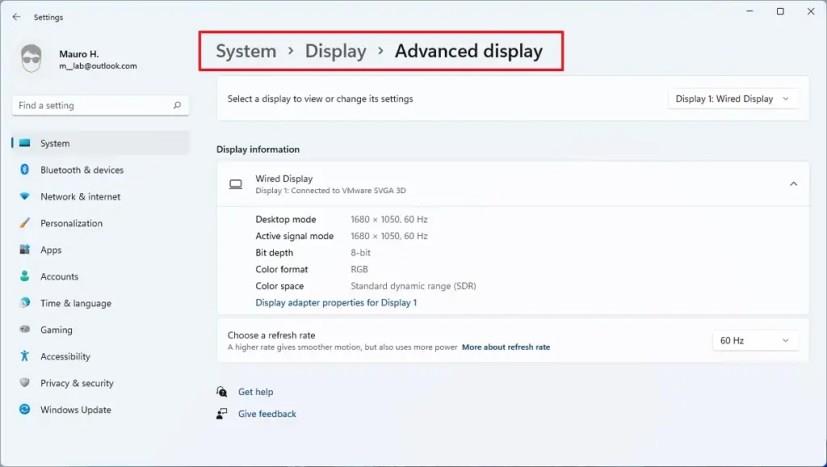
Settings breadcrumbs
Finally, the new Settings app can now recommend settings adjustments based on their current state.
System settings
The System section is the new default page when you open the Settings app. It now includes the pages to adjust many settings, including Display, Sound, Notifications, Focus assist, Power, Storage, Nearby sharing, as well as Multitasking, Activation, Troubleshoot, Recovery, Projecting to this PC, Remote Desktop, Clipboard, and About.
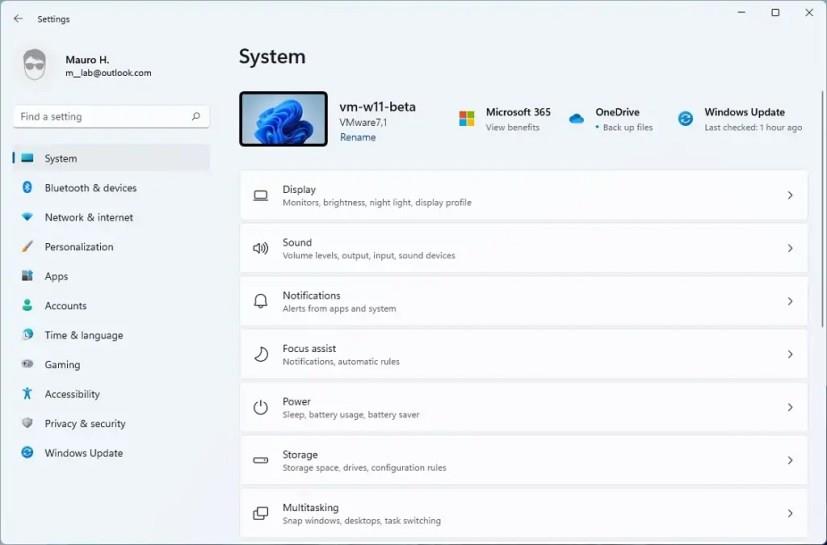
System section
Also, the hero controls in this section include desktop preview, device name, and option to rename the system, and you will find icons with the status of OneDrive and Windows Update.
Display
On the “Display” page, the Scale & layout section introduces new settings to remember window locations based on monitor connection and window locations based on monitor connection to improve the experience when working with more than one monitor.

Multiple displays
These settings are part of a new experience on Windows 11 that allows you to restore apps automatically to their original location when reconnecting an external monitor.
You will notice a new “Automatically adjust contrast based on the display content to help improve battery” option, under the Brightness setting, to disable content adaptive brightness control (CABC) on Windows 11.
In the “Advanced display” page, there is a new option (Dynamic) to enable the new Dynamic Refresh Rate (DRR) feature in the refresh rate setting.
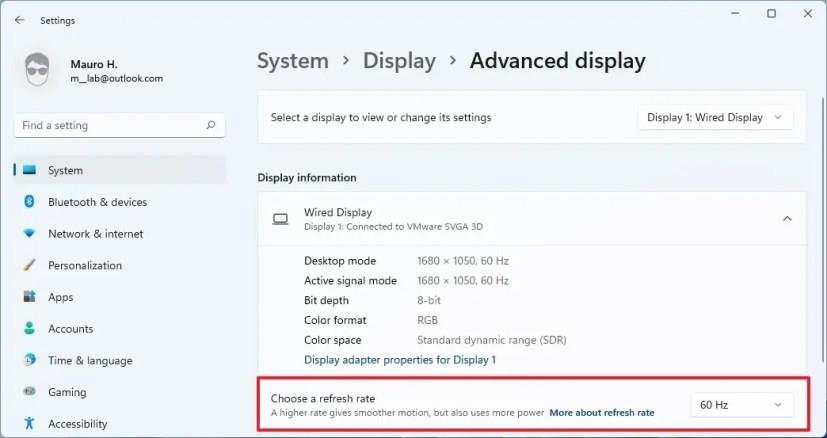
Dynamic refresh rate
If you choose this option, Windows will automatically lower or increase the display refresh rate to reduce the power consumption on supported hardware.
Also, if the display is certified as HDR, you will know this information on this page.
On the “Graphics” page, there is a new search box and list of apps you may want to customize.
Also, the Night light page is not getting new settings, but when turning the night light on or off manually through the Settings app or Action Center, the feature will now turn off immediately rather than using slow transition.
Sound
On the Sound page, you will find an option to enable mono audio for people with difficulty hearing, and there is an option to pair output devices quickly.
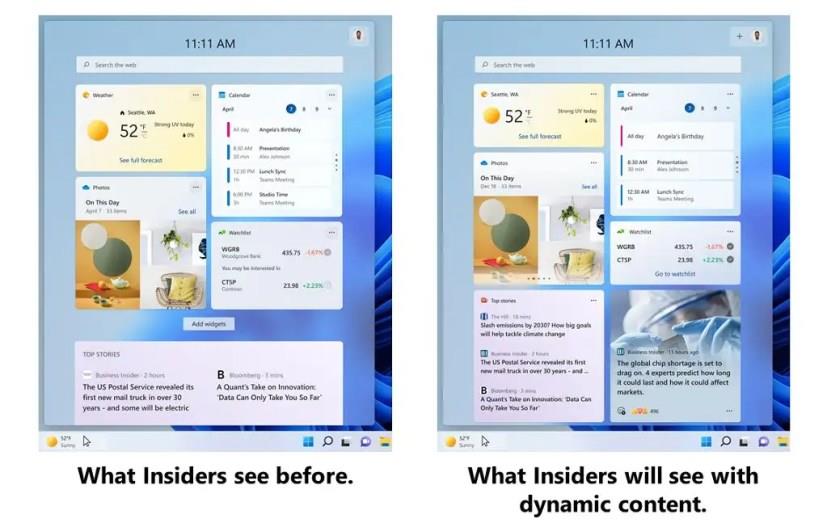
Mono audio
Under the “Advanced” section, you will find a new option to access all the sound devices, troubleshoot, and others.
The “App volume and devices preferences” page has become the “Volume mixer.” The page still has all the same settings, and it replaces the legacy Taskbar volume mixer menu.
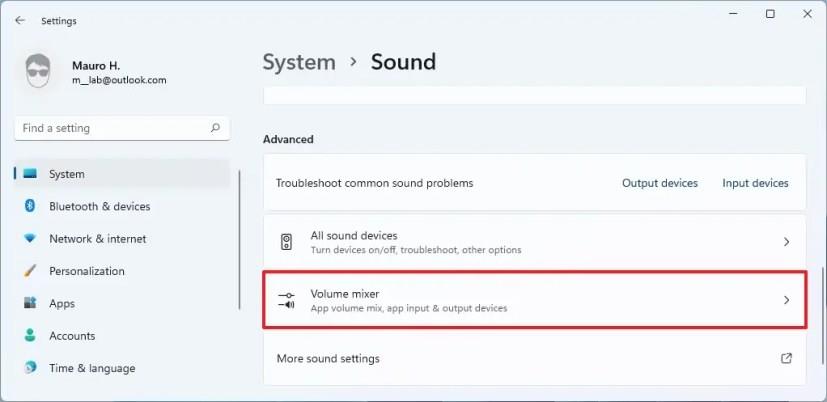
Windows 11 Volume mixer
The Properties page for devices has been redesigned with high-quality icons, driver information, and new settings.
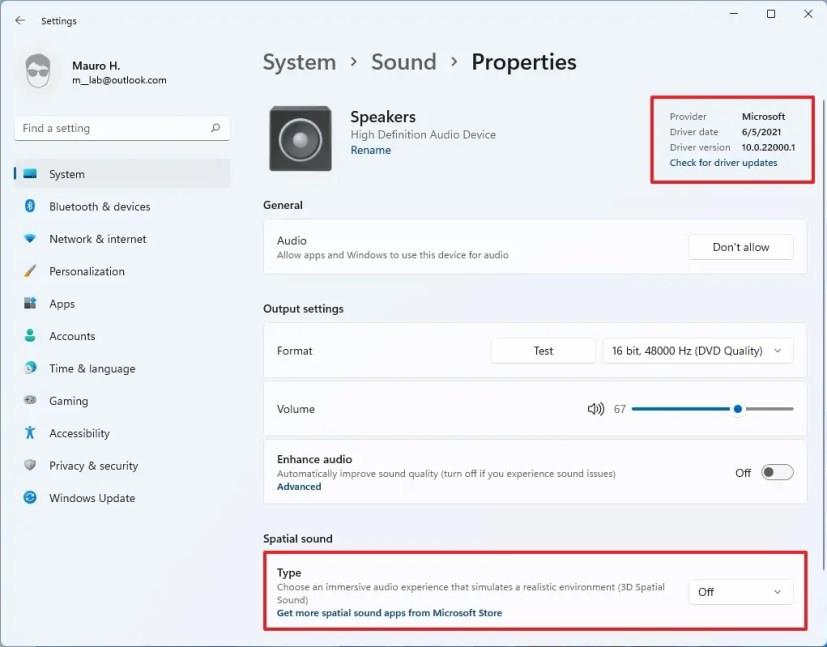
Sound properties
The Speakers page now houses permissions to allow or deny apps access to the output device. You can choose the audio format, adjust the volume, and enable Spatial sound. Also, you can now rename the device, see the driver information, and check for driver updates.
Notifications
On the Notifications page, you only have three settings, and there’s an option to access the “Focus assist” settings page.
Power & battery settings
The Power & battery page now displays the battery usage over time.
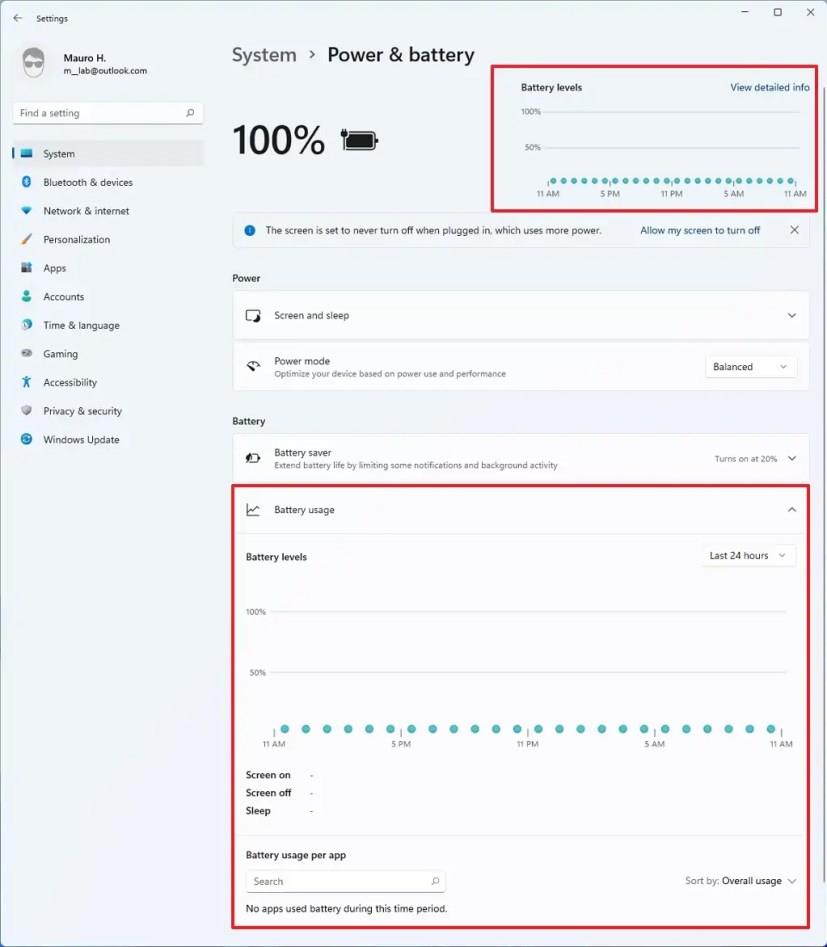
Power & battery settings
Storage
The Storage page has been updated with new features, and the information about the system drive is now front and center.
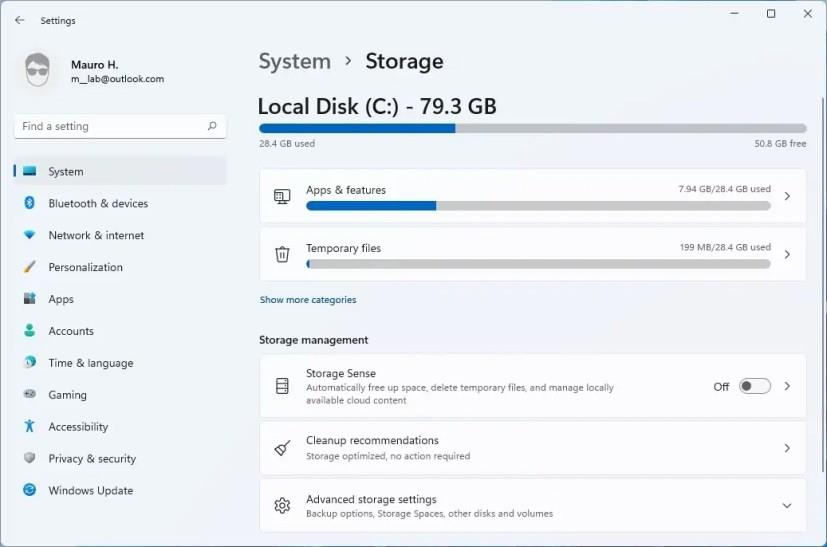
Windows 11 Storage settings
Storage sense is now located under the “Storage management” section. The only change on the Storage sense page is the new option to run the cleanup of temporary files automatically.
The Windows 11 Storage sense has a new feature known as Cleanup recommendations that shows how many large files and used files, synced files to the cloud, unused apps you can uninstall, and the temporary files you can delete to free up space.
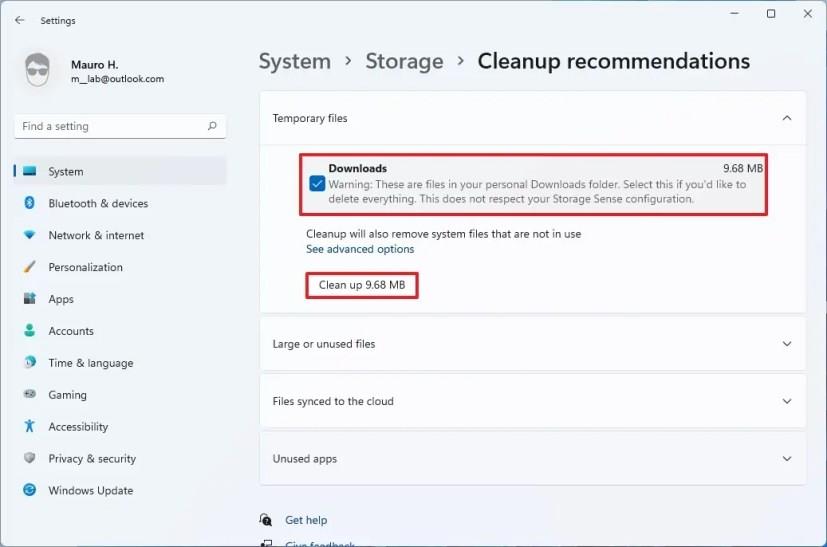
Cleanup recommendations
The feature is straightforward. You only need to select the items and click the “Clean up” button to free up additional space.
In the “Advanced storage settings” section on the main Storage page, you will find the new Disks & Volumes feature that replaces the legacy Disk Management experience.
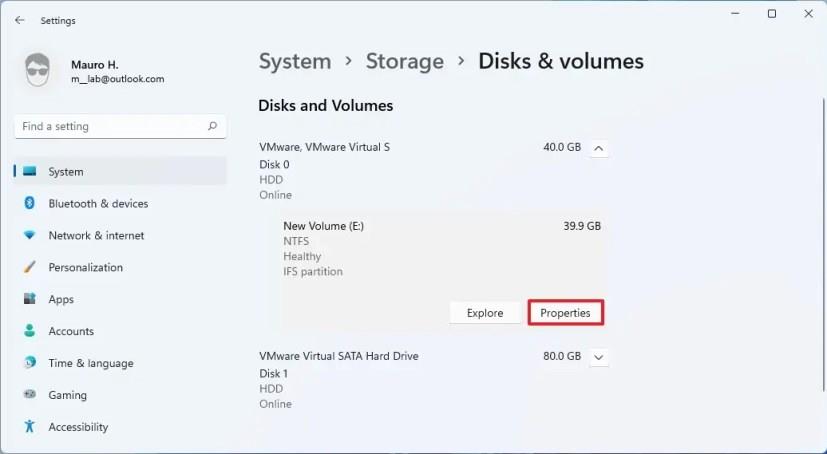
Disks and volumes
Windows already has a tool to manage disks and volumes, but it’s an old control panel experience. The new experience was built from the ground up with modern improvements and accessibility in mind. It also features better integration with features, such as Storage Spaces and the Storage breakdown page.
Like the legacy tool (which is still available), the new tool allows you to view all the drives connected to the device, and you can create, resize, format, and change letters for partitions.
On the page, the disk tool shows all the drives connected to the device with basic information, such as the disk number, media (SSD or HDD), and whether if the drive is online or offline.
You can select the drive and click the Properties button to give you additional information like name, identification, model, media, capacity, and type. You’ll also see the current status and the partition style (for example, GUID Partition Table “GPT”).
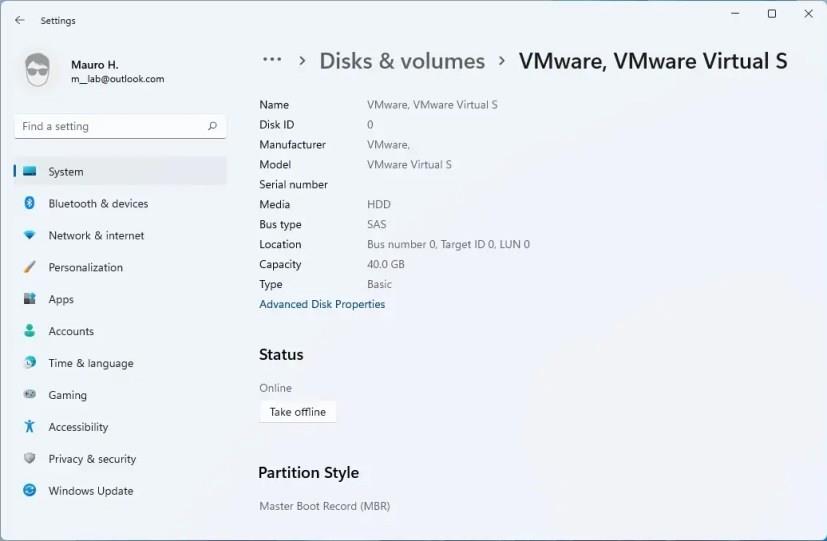
Hard drive information in Settings
The Advanced Disk Properties option opens the properties of the drive with the Control Panel.
While on the main page, if you expand the drive, you will see the list of partitions with rich details, including the file system, partition type, status, and more.
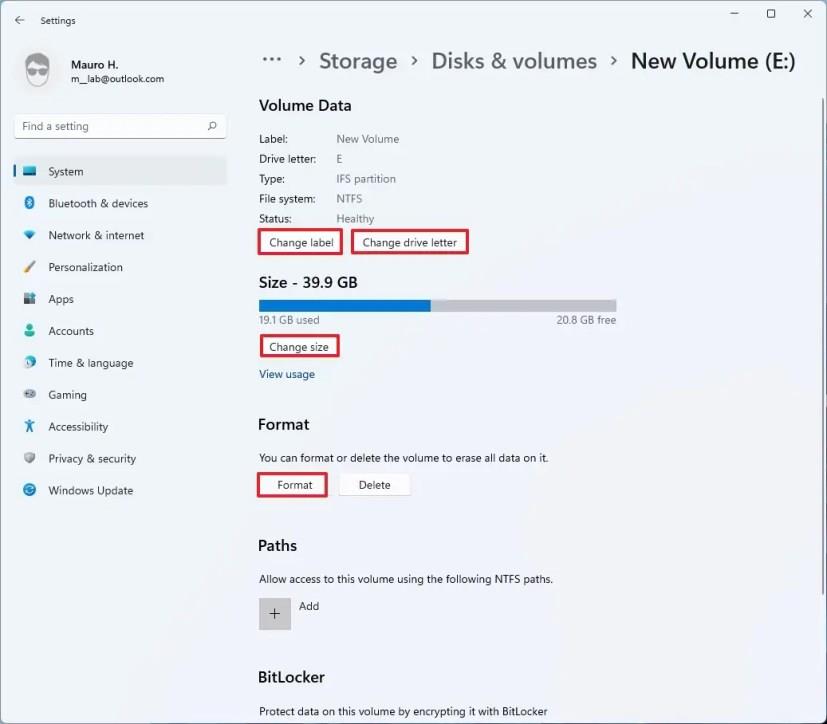
Settings partition info and tools
In addition, the experience includes a health monitor feature to keep tabs on the health of Non-Volatile Memory Express (NVMe) Solid-State Drives (SSDs).
If there is an issue with the drive, you will see a notification to view more details and access the drive to back up the data before it’s too late. The notification will open the drive page, where you can find more information, including the life remaining on the drive, temperature, and available space.
You can select each drive, and clicking the Properties button will access another page where you can change the label or drive letter. You can resize the partition with the Change size button. You can add a path to the volume, and you can even enable BitLocker on the drive.
If you are dealing with an external drive, the properties page will also include options to delete and format the partition, and you can bring the drive online or offline.
Windows 11 is also bringing Storage Spaces to the Settings app. This means you can now create and manage storage pools and spaces, add and remove drives, and optimize pools within the Settings app without opening Control Panel or PowerShell.
Multitasking
On Windows 11, the Multitasking page includes the options to enable and disable Snap layouts, Snap groups, and more.
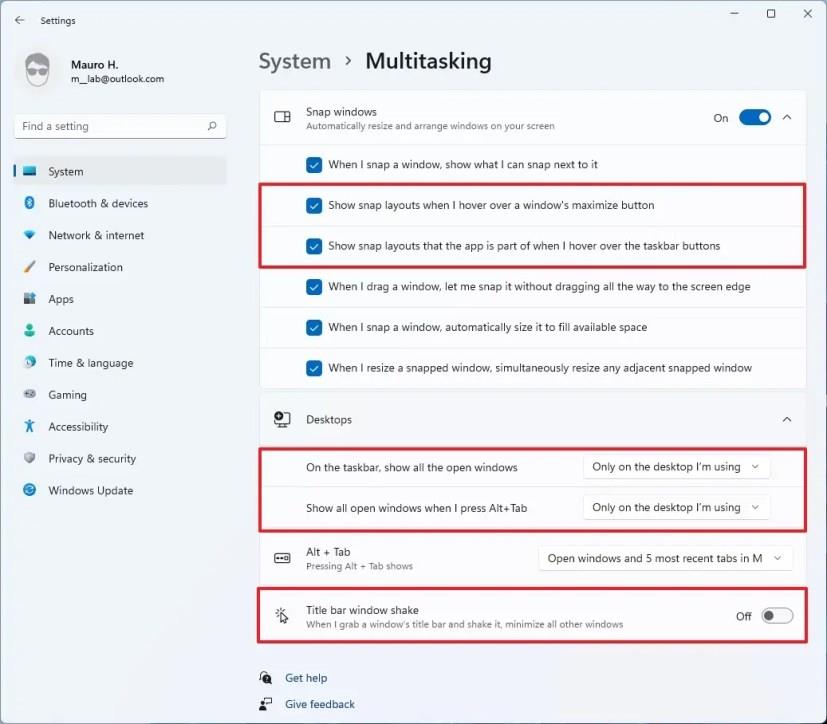
Multitasking settings
Also, the “Virtual Desktops” settings have been renamed to “Desktops,” and the settings are all the same ones as before. And now, the Settings app includes an option to enable or disable the title bar window shake (Aero shake) feature.
Bluetooth & devices settings
The Bluetooth & devices section has also been updated to make it easier to connect peripherals to Windows 11. This section includes the settings to control Bluetooth, Devices, Printers & scanners, Your Phone, Cameras, Mouse, Touch, Pen & Windows Ink, AutoPlay, and USB.
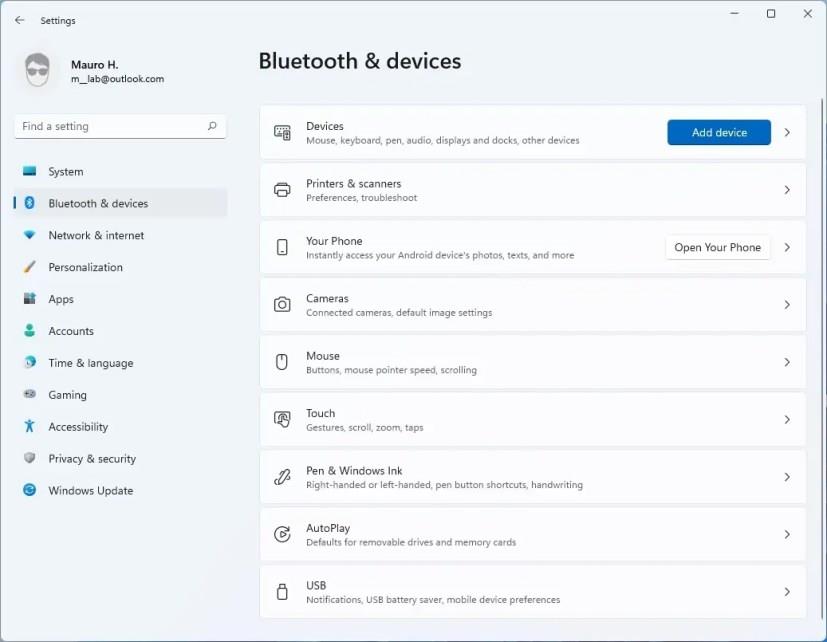
Bluetooth & devices settings
Devices
On the Devices page, you will see a list of the input, output, and other devices connected to your computer. And the Add device will open the wizard to install new peripherals like on Windows 10. If you no longer need a device, you can remove using the peripheral’s menu on the right side.
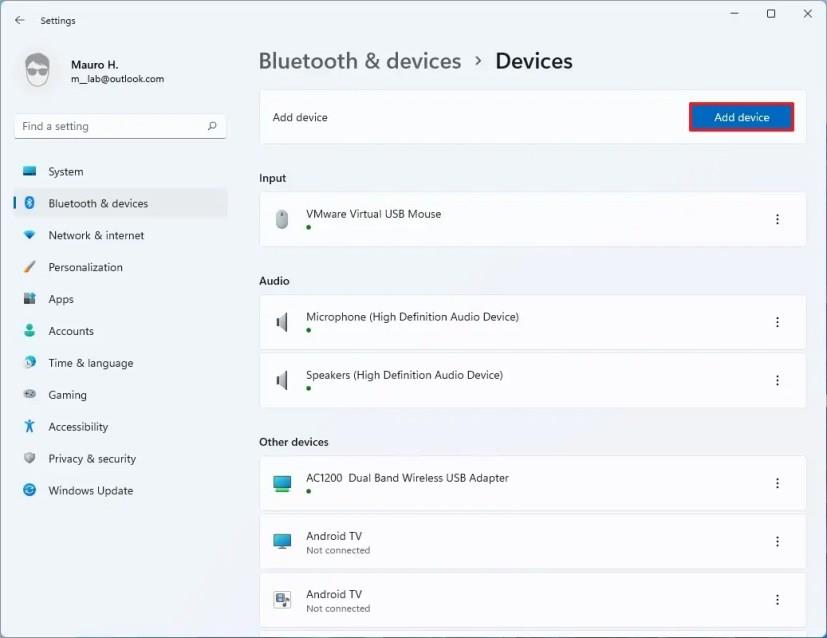
Windows 11 Devices settings
This used to be the “Bluetooth & other devices” page.
Cameras
The Cameras page is new to Windows 11, and it houses the settings to manage webcams and network cameras.
Camera settings
You can manage features like brightness, contrast, rotation settings, and even enable or disable Video HDR and Eye Contact in the camera settings. The Video HDR and Eye Contact features are only available in supported hardware.
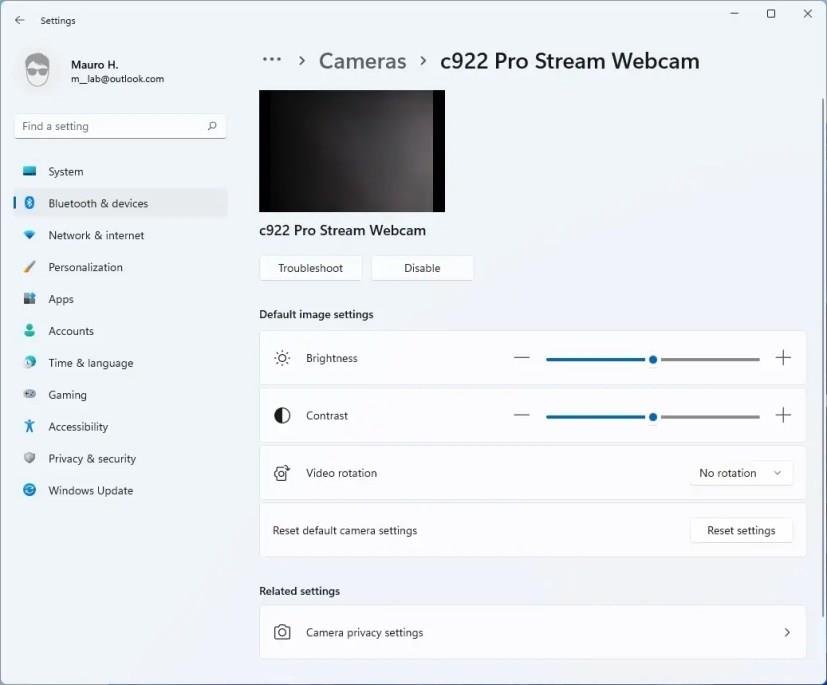
Webcam configuration
Touch
The Touch page is also new, and it’ll be available on devices with touch screens.
Network & internet settings
In the Network & internet section for hero controls, you will see the active network connections, connection properties, and data usage. This part of the Settings app includes the settings for Ethernet, Wi-Fi, VPN, Mobile hotspot, Airplane mode, Proxy, Dial-up, and Advanced network settings.
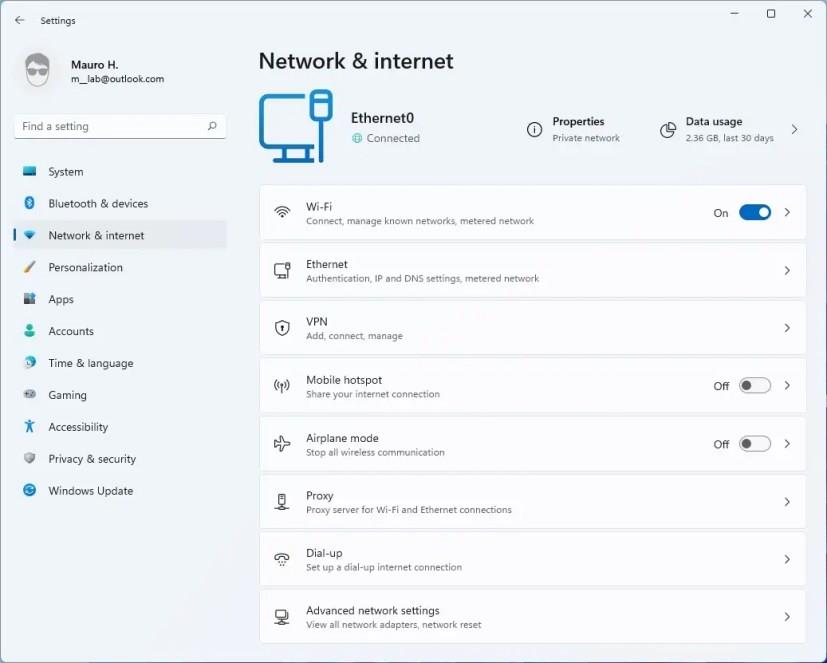
Windows 11 Network & internet
Wi-Fi
The Wi-Fi page isn’t new, but it has been tweaked with an option to view the available wireless networks within the app.
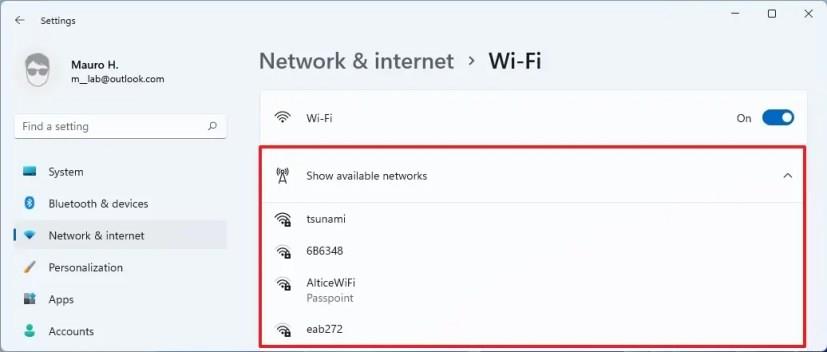
Windows 11 Wi-Fi settings
Ethernet
The Ethernet page now includes an option to set up IEEE 802.1x network authentication settings. (In previous versions, this needed to be done in Control Panel.)
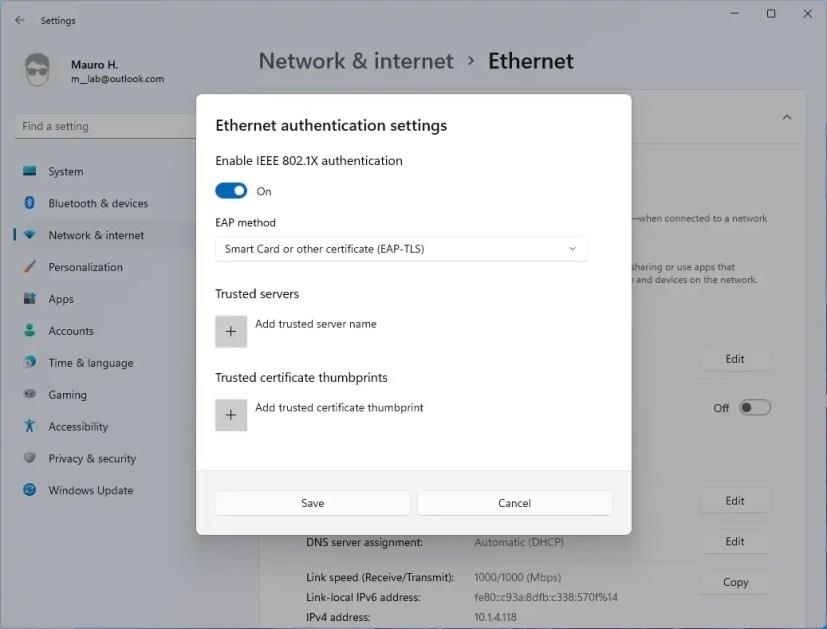
IEEE 802.1X authentication
You can now configure Domain Name System (DNS) without opening the Internet Protocol (IP) configuration page.
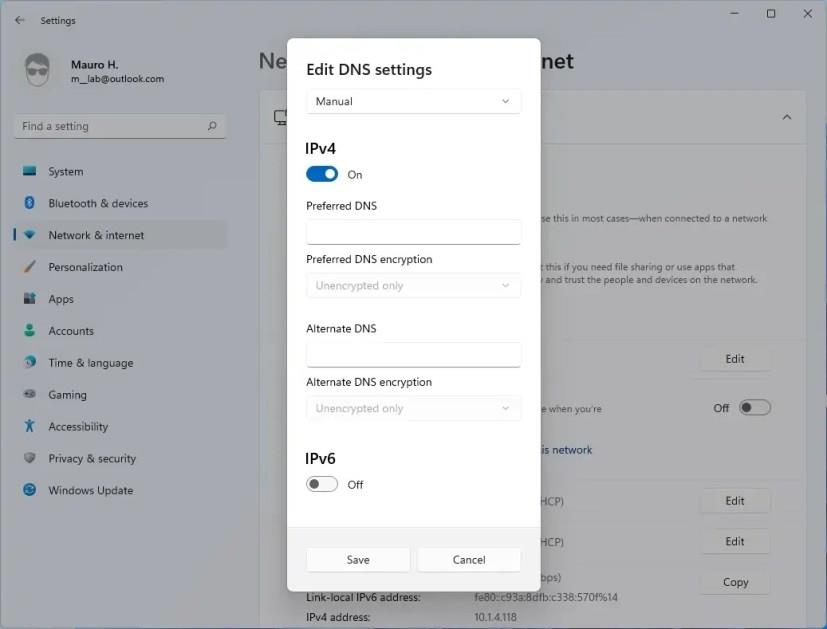
Windows 11 DNS only settings
Finally, starting on Windows 11, you can configure DNS over HTTPS (DoH) to encrypt DNS queries using the Hypertext Transfer Protocol Secure (HTTPS) protocol.
Advanced network settings
The Advanced network settings page is new, and it includes the options to enable or disable, rename, and view the status of network adapters. (In previous versions, this needed to be done in Control Panel.)

Advanced network settings
Personalization settings
While the Personalization section is not new, it has a lot of improvements. For example, the section now shows the six new default themes and a preview of the desktop as hero controls, and it houses the settings for Background, Colors, Themes, Lock screen, Touch keyboard, Start, Taskbar, Fonts, and Device usage.

Windows 11 Personalization settings
Themes
The Themes page is almost identical to the previous version, with the difference that it includes six new default settings.
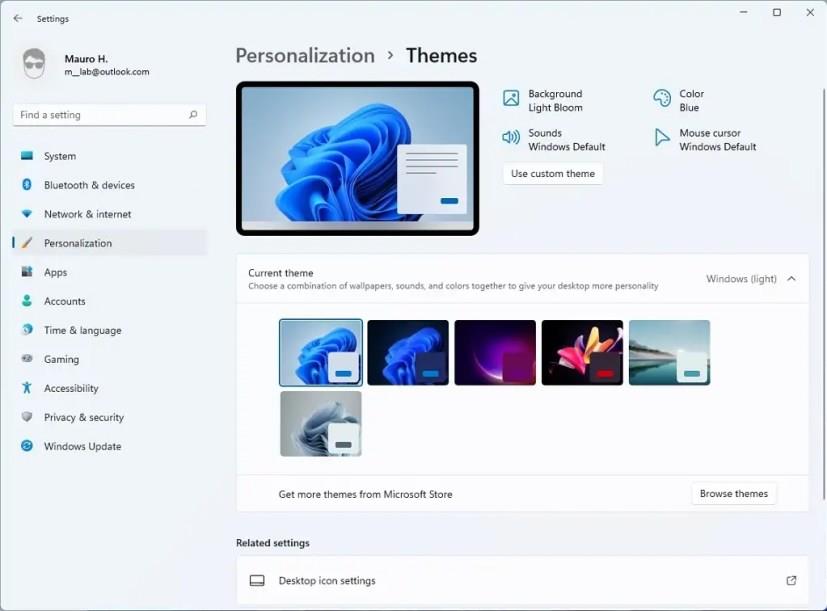
Themes settings
On the Sounds page, you will also find that the “Play Windows Startup sound” option is now enabled by default, and this is because Windows 11 is also bringing back the startup sound again. However, the Windows startup sound will not play after the computer reboots automatically to apply updates.
In addition, you will now find new default sounds for pretty much every action in the latest version of Windows. Microsoft has been created a slightly different sound theme when using the dark mode.
Windows 11 startup sound
You can check out the new sounds by selecting each event and pressing the Test button.
Touch keyboard
The Touch keyboard page is new and houses the settings to adjust the on-screen keyboard, including settings to change the keyboard size, theme with the option to show background and change the size of keys.
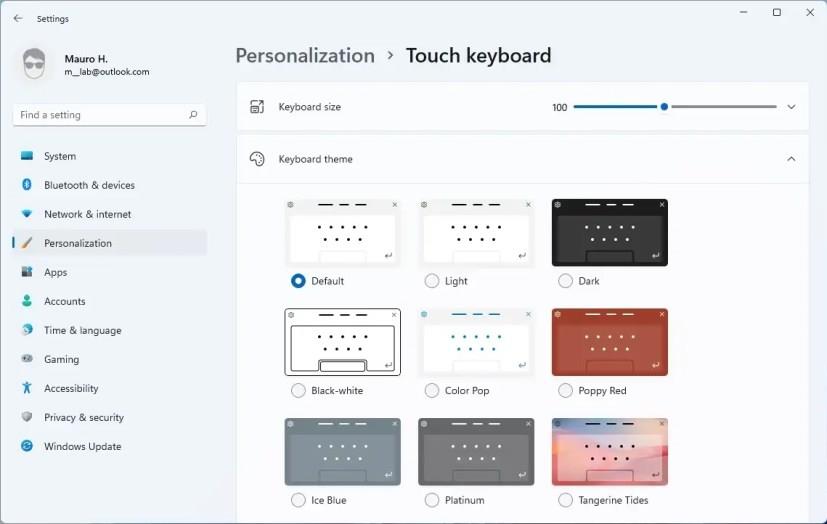
Touch keyboard settings
Start
The Start page includes the new settings to customize the Start menu. For instance, you will now find the options to show or hide recently added and most-used apps. You can also control whether or not to show items in the jump list and the “Recommended” section.
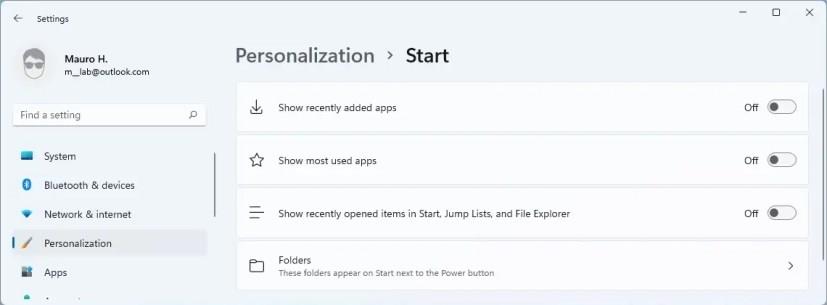
Start settings on Windows 11
In addition, the Folders setting lets you decide what folder (or quick links for File Explorer, Settings, etc.) appear next to the profile menu in the Start menu.
Taskbar
The Taskbar page no longer includes the options to change the Taskbar location, height, or icon size. Instead, the settings reflect the new features, including showing or hiding the Search, Task View, Widgets, and Chat buttons.
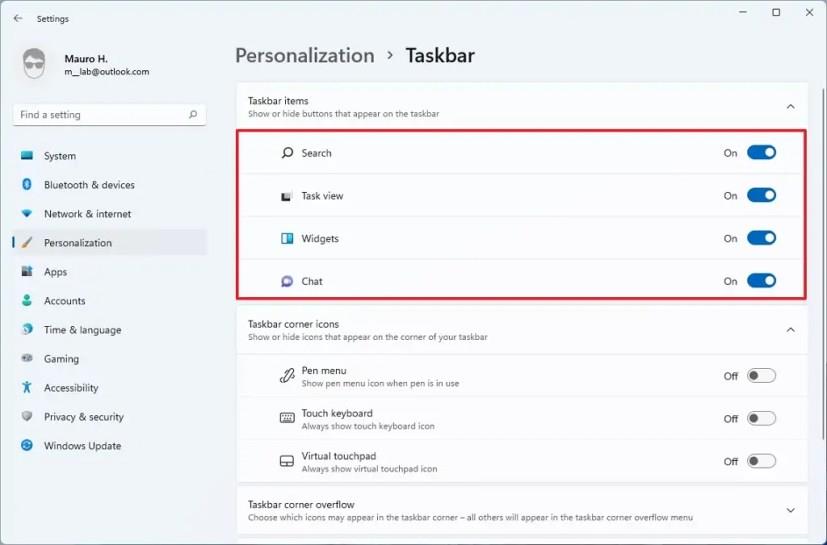
Taskbar settings
You can show or hide the “Pen menu,” “Touch keyboard,” and “Virtual touchpad” buttons that appear in the system tray. Also, you can control which items appear in the overflow menu.
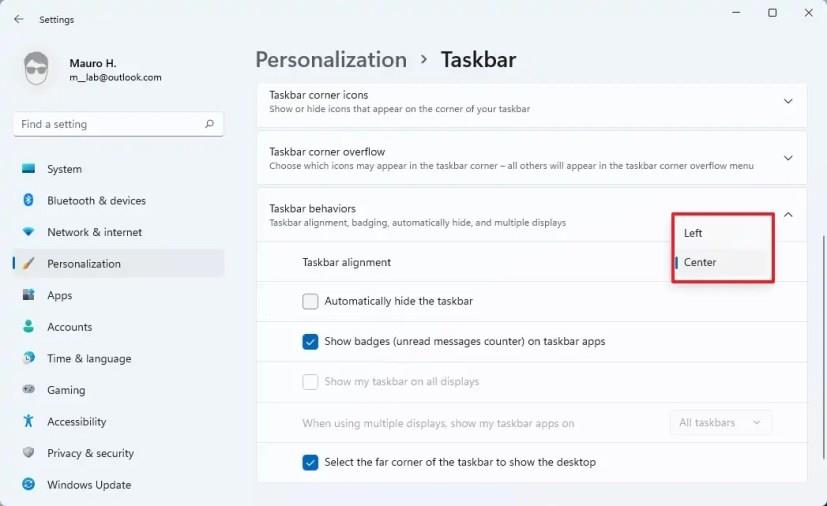
Taskbar behaviors
Finally, in the “Taskbar behaviors” settings, you can change the Taskbar alignment to the left and center. You can also enable auto-hide the Taskbar, show badges for unseen messages, disable the show desktop button, and control the experience in a multiple display setup.
Device usage
The Device Usage is new, and it lets you specify how you plan to use the computer so that Windows 11 can tailor the ad experience.
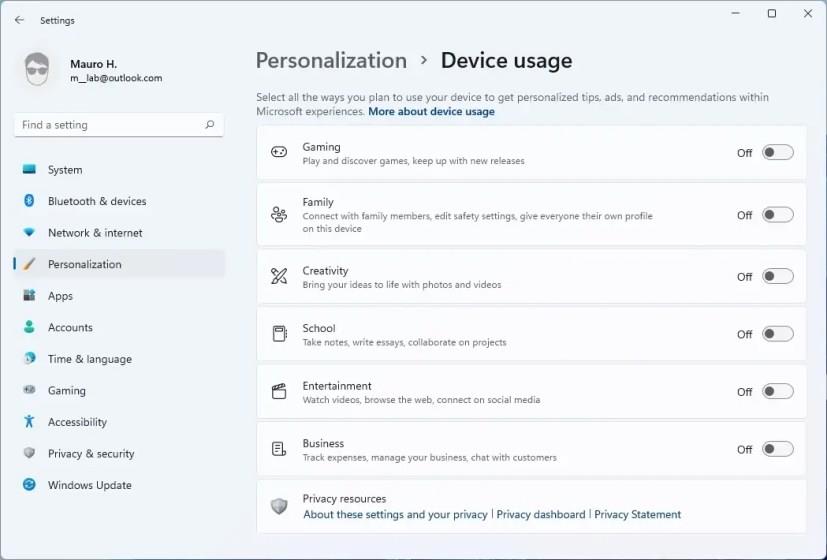
Device usage
Apps settings
The Apps section includes the settings for Apps & features, Default, Offline maps, Optional features, Apps for websites, Video playback, and Startup.
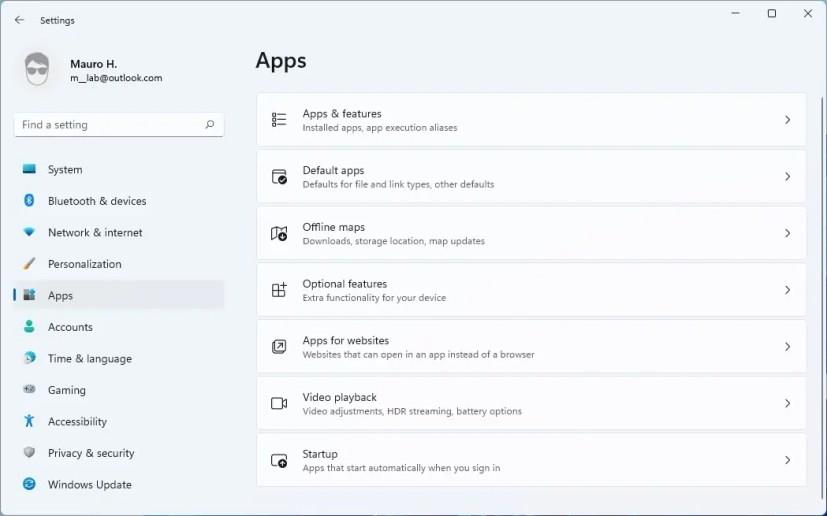
Windows 11 Apps settings
Apps & features
The Apps & features page is not changing significantly, but you will find a new “Share across devices” feature, allowing you to pick up an app you left off on another device.
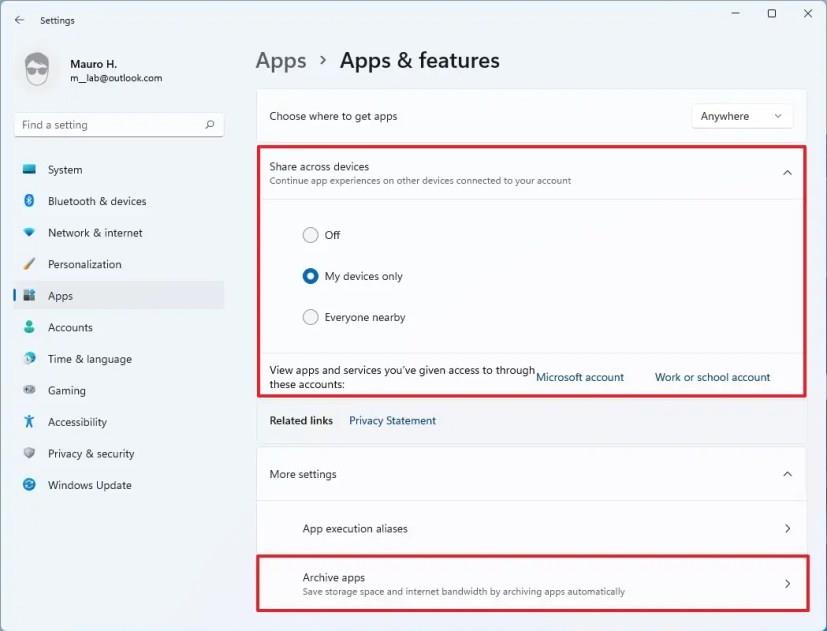
Apps & features settings
When you select “More settings,” you will notice a new Archive apps feature.
The feature is meant to archive apps you don’t often use to save space and internet data. The next time you try to open the app, it’ll connect to the internet and download the full version again. Of course, this is if the app is still available in the Microsoft Store.
Optional features
The Optional features page used to be part of the “Apps & features” page, but it’s now a separate page.
Accounts settings
The Accounts section displays the current user information, OneDrive, and Microsoft Bing rewards details for hero controls. As part of the settings, in this section, you will find the settings for Your info, Email & accounts, Sign-in options, Family & other users, Windows backup, and Access work or school.
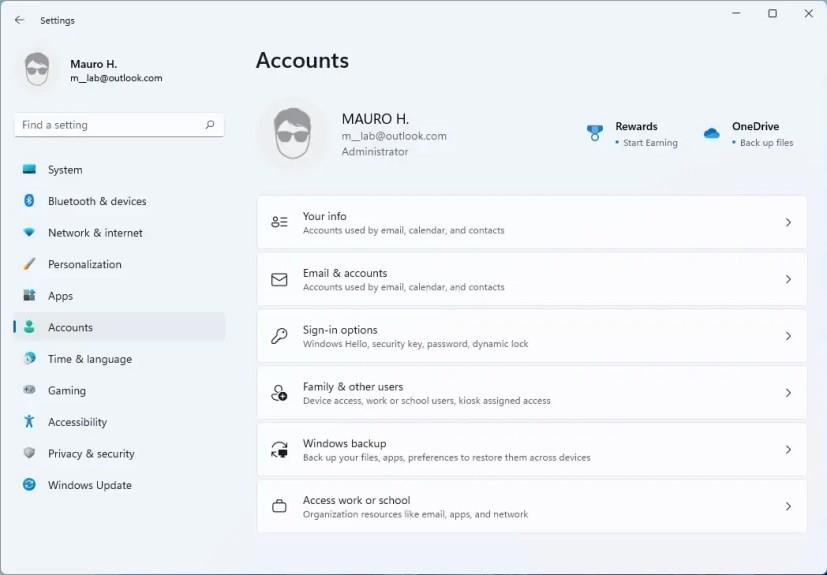
Windows 11 Accounts settings
Windows backup
The Windows backup page is new to Windows 11 and includes the settings to control the OneDrive folder syncing and sync app and system preference settings to the cloud.
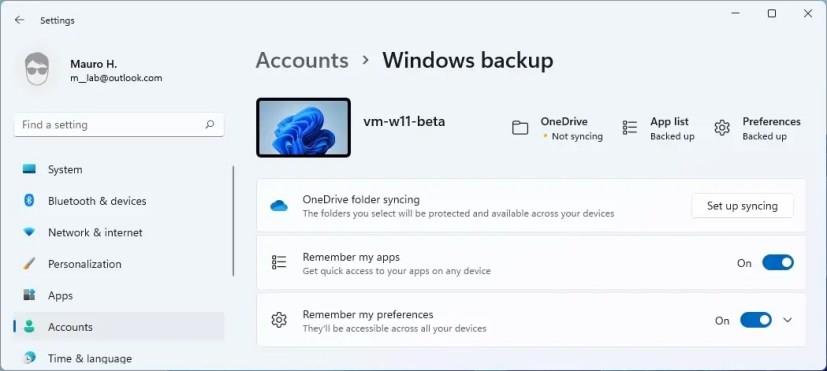
Windows Backup settings
For control heroes, you will see the status for “Preferences,” “App list,” and “OneDrive backup.”
Time & language
The Time & language section includes the settings for Date & time, Language & region, Typing, and Speech pages.

Windows 11 Time & language
Typing
The Typing page isn’t new to Windows 11, but the settings were located in the “Devices” section.
Accessibility
Formerly known as “Ease of access,” the Accessibility section houses the settings Text size, Visual effects, “Mouse pointer and touch,” Text cursor, Magnifier, Color filter, Contrast themes, Narrator, Audio, Captions, Speech, Keyboard, Mouse, and Eye control.
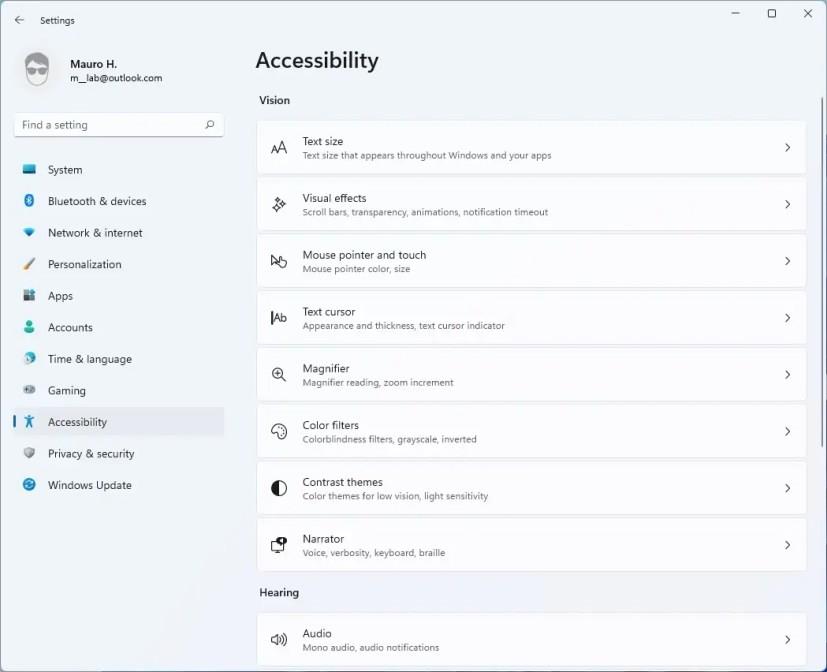
Windows 11 Accessibility settings
Visual effects
The “Display” settings page has now been renamed to “Visual effects,” and the settings are the same as before.
Mouse pointer and touch
The “Mouse pointer” page has been renamed to “Mouse pointer and touch,” and the settings are the same as before.
Privacy & security
On Windows 11, the “Privacy” page has been renamed to “Privacy & security.” This page includes the settings for General, Speech, Inking & typing Personalization, Diagnostic & feedback, and Activity History. Also, in this area is where you will now find Search permissions and Searching Windows pages.
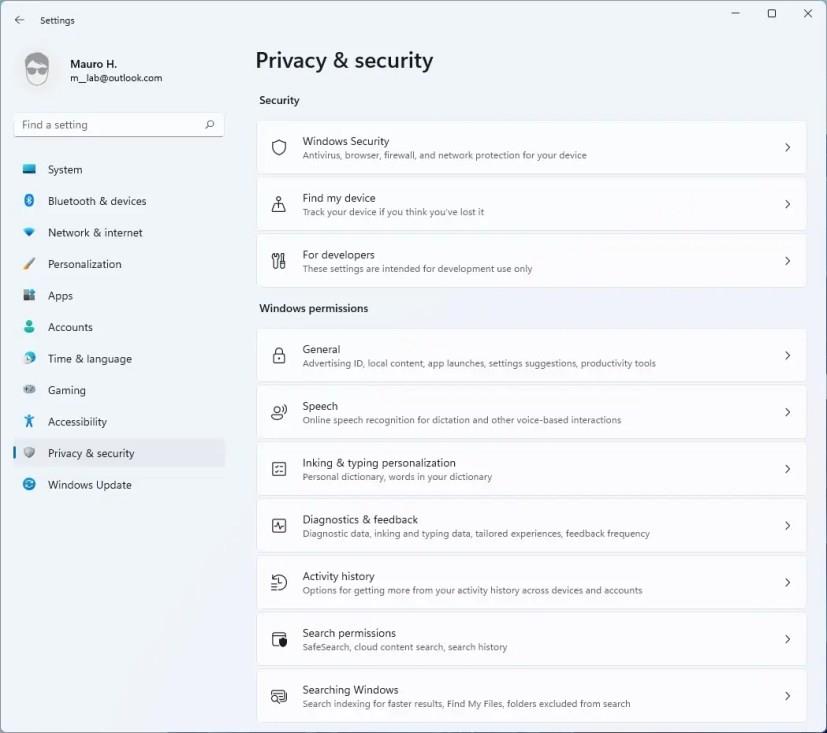
Windows 11 Privacy & security settings
Since this section also includes security settings, you will find the Windows Security, Find my device, Device encryption, and For developers pages.
Screenshot borders
On Windows 11, the Screenshot borders page is new, and it allows you to control if apps can choose to access the screenshot borders.
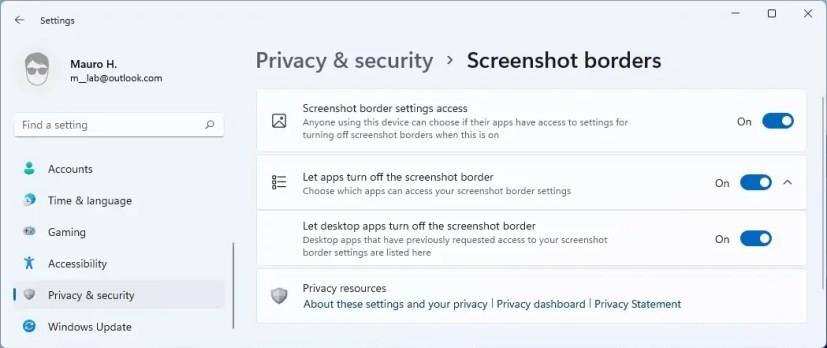
Screenshot borders settings
Screenshot and apps
The Screenshot and apps page is new for this release, and it includes the settings to decide which apps can grab screenshots.
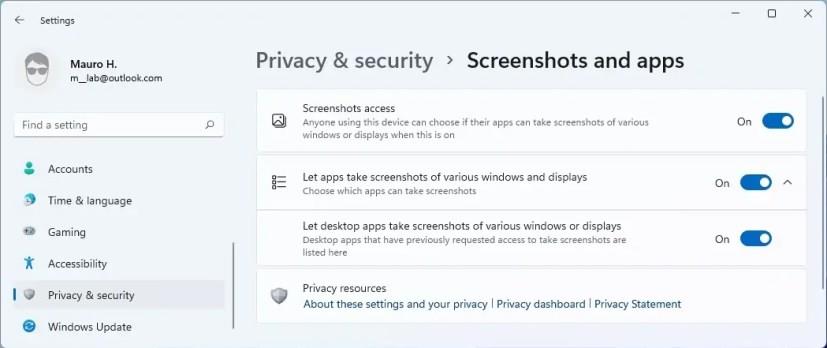
Screenshots and apps settings
Windows Update
The Windows Update section is a new section on Windows 11. The page now includes colorful icons and improvements to communicate the status of updates better. Also, in this section that’s where you will find the settings to view the Update history, access the Advanced options, and enroll a computer in the Windows Insider Program.
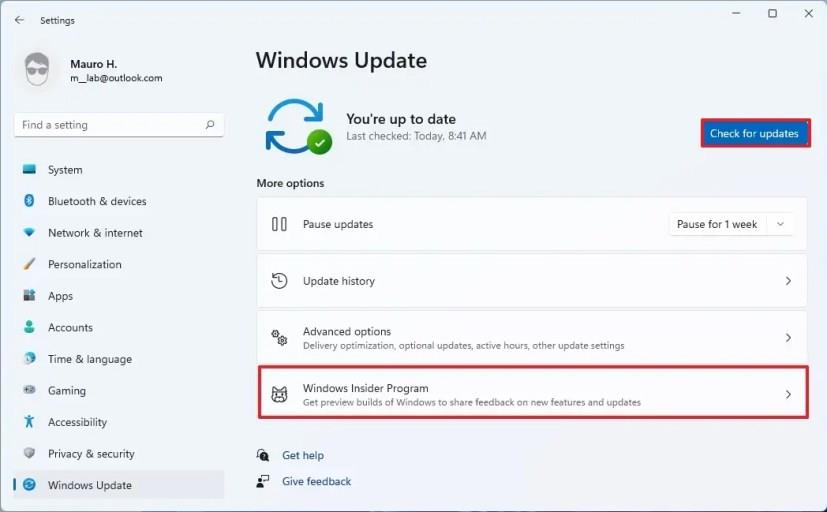
Windows Update settings
In addition, when a new update is ready for your device, the Settings app will inform you how long it will take to apply it. However, this feature is only available for Solid-State Drives (SSD) devices.
Advanced options
The Advanced options page now includes a Configured update policies page that shows all the Group Policy policies currently applied to the device.
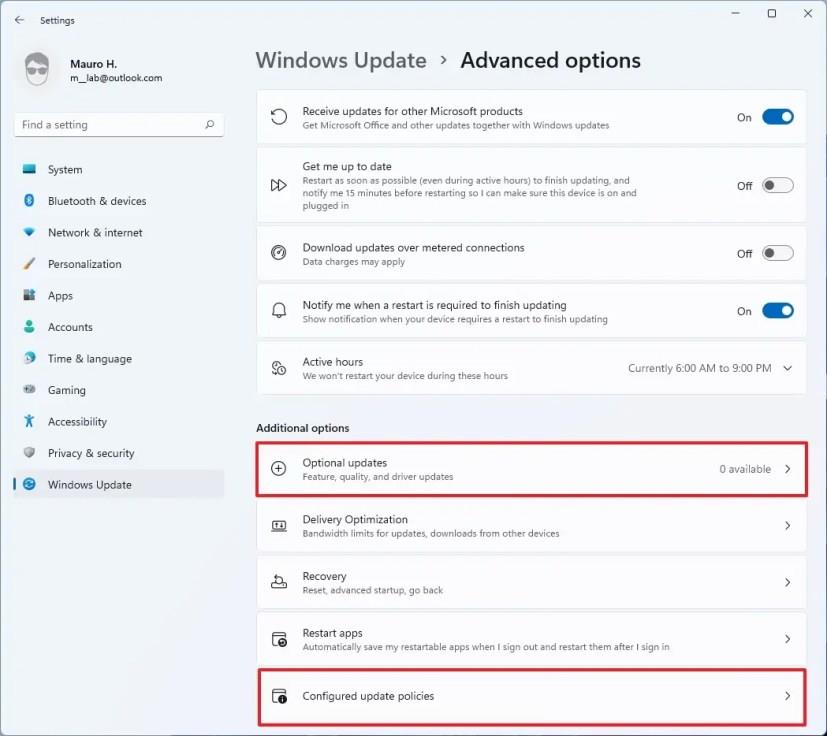
Advanced options
Also, on this page, you find the page to view and install optional updates available for your device.
Language updates
The Scottish Gaelic keyboard now uses AltGr + 7 to input ⁊ (U+204A TIRONIAN SIGNET), pressing’ will now insert the characters, and Alt Gr +’ now acts as a dead key to add the acute accent with a subsequent letter.
Also, when pressing Shift + 6 will now insert ߾ (U+07FE ), and pressing Shift + 7 will now insert ߿ (U+07FF) for the N’Ko keyboard layout.
Japanese IME improvements and touch keyboard
Windows 11 updates the new Japanese IME to support switching between Hiragana and Katakana using CTRL + CAPSLOCK and ALT + CAPSLOCK (respectively), as it was supported with the previous version.
Microsoft is also introducing the “50-on touch keyboard” layout for the Japanese language. This is a popular layout that allows you to input Japanese texts intuitively without knowing how to compose Hiragana characters.
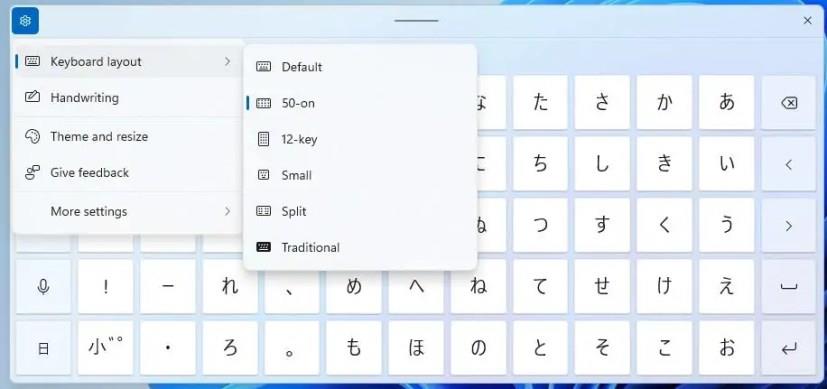
Japanese 50-on keyboard layout
You can use the new layout by clicking the Settings button and selecting the “50-on” option. It also provides alphabet and symbol views newly explicitly designed for the layout.
Input Method Editor (IME)
Microsoft is introducing a new version of all available IMEs that includes a new modern design using the Fluent Design System, including acrylic background, selection visual, and dark theme support.
There are some font adjustments in the candidate interface to minimize intrusiveness while securing visibility. Also, the new design is expanding to more languages.
Also, in this version, Windows integrates the new IME candidate windows design for Japanese, Chinese Traditional, and Indic IMEs.
Korean IME improvements
If you type in Korean, you’ll also find a new version of the Korean IME with improvements in the typing experience.
Windows Subsystem for Linux (WSL) new features
Windows 11 ships with an updated version of the Windows Subsystem for Linux (WSL) that supports the ability to install Linux GUI (graphical user interface) apps as if they were natively installed on Windows.
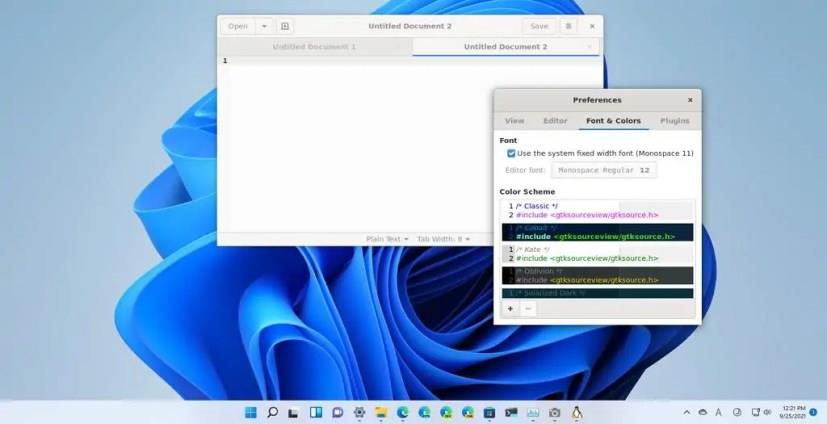
Linux GUI apps on Windows 11
In other words, you can now use your favorite Linux editors, tools, and applications on Windows 11 without the need to switch devices or create a virtual machine.
The feature is meant to develop and test your apps on Linux, but you can use this implementation for any situation. The Linux GUI apps on Windows even include support for speakers and microphones, which means that if you install a media app, the peripherals will pass through and appear in the app. GPU accelerated 3D graphics are also supported to run any app that needs to do complex 3D rendering leveraging OpenGL.
When using this feature, you do not have to run an X server manually since WSL automatically starts a new “companion system distro,” which includes a Wayland, X server, pulse audio server, and all the required components. After you close the app and the WSL session, the system distro will end automatically.
Once the Linux GUI app is installed, it will register in the Start menu, which means that you can launch the app by typing the name on the Windows Subsystem for Linux (WSL) console, or you can launch it like if it was any other application using the Start menu.
If you launch the app from the Start menu, you will find the entry in the “Recently added” list, and you can find it inside the (distro name) folder below the Linux distro entry.
You will also notice that the Taskbar will show the icon with a Linux logo, indicating that you are not running a Windows 11 application.
The experience using a graphical Linux app on Windows 11 feels native, but it’s not. The app renders with all the Linux visual styles for the frame, menus, and other elements, and there is even a shadow around the frame, and every window works independently. However, it is a remote desktop connection, which Microsoft is likely leveraging with the RemoteApp feature built into the operating system.
File Explorer with Linux integration
Also, in WSL, the default path has been changed to \\wsl.localhost\\ from \\wsl\\ to improve reliability and performance. However, you will still be able to use the \\wsl\\ path to access the files.
New WSL install and other changes
The Windows Subsystem for Linux is also getting a few more features, including GPU compute, wsl --install command, and wsl --update command.
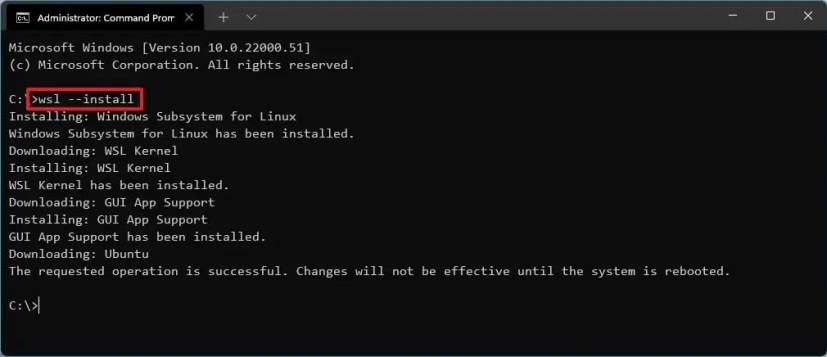
Windows 11 install WSL command
The GPU compute is a feature that allows the Linux binaries to leverage graphics cards, making it possible to perform more machine learning development and data science workflows directly in WSL.
The wsl --install command lets you install the WSL components aster, and the wsl --update command gives you the ability to manage the Linux kernel version used by WSL 2 distros.
The custom Linux kernel from the Windows system image has been removed, and it’s now available through the Microsoft Store.
On Windows 11, you can now attach and mount physical drives inside the Windows Subsystem for Linux distros. The feature enables you to access file systems that are not natively supported (for example, ext4). This means that if you have a dual-boot system with Windows 11 and Linux and are using different drives, you can now access your Linux files from Windows 11.
Also, there is a new option to run Linux commands on the startup of a Windows Subsystem for Linux (WSL) distro.
If you want to use this feature, you will need to edit the /etc/wsl.config file on the distro and adding an option named “command” under the “boot” section.
Windows 11 new system optimization and enhancements
Yes, Windows 11 makes laptops and desktop computers a lot faster. Alongside the redesigned experience and new features, the new version also introduces several under-the-hood improvements to utilize resources better to make the system more responsive.
Snappier and more responsive
For example, under heavy load (even at 90 or 95 percent), Windows 11 will redistribute the compute resources to launch without any lag when launching an app.
This technique also applies to the Windows shell itself, the browser, and your open tabs, but using Sleeping tabs, reducing around 32 percent of memory and 37 percent of processor usage.
When you combine all these new improvements will result in longer battery life and better performance.
Faster resume from sleep mode
Microsoft has also been working to make resume from sleep mode faster. This was possible because of the optimization done for calling hardware components that have to turn on to resume from sleep to improve memory management.
In addition, at the software layer, Windows 11 is making code changes that translate to around 25 percent faster resume times. Using these new techniques, Microsoft claims that most users will resume their devices from sleep “almost instantaneously,” and the device can “stay in sleep state longer and not hibernate as often.”
Faster Windows Hello sign in
Windows 11 also ships with “code optimization” that makes the Windows Hello sign-in process up to 30 percent faster as part of the performance improvements.
Reduced system footprint
Furthermore, Windows 11 reduces the overall footprint. This was done by expanding the use of compression technologies. Also, non-critical built-in apps and other components (such as Microsoft To Do, Sticky Notes, Power Automate) their default state is now “stub” that also reduces the space on the hard drive, background download activity, and download traffic.
And Windows 11 also reduces the storage consumption caused by the system and browser caches.
Smaller and faster updates
After installing Windows 11, you will notice that updates will download and install faster. This is because Windows includes several optimizations to the update engine, which improves how updates are packaged.
For example, when a new update is released, Windows 11 will compare the components available in the computer and then only pulls down the necessary changes, making updates up to 40 percent smaller.
Also, instead of two, Microsoft is now planning to only release one feature update per year.
First-run experience
The new OS introduces a new first-run experience using the updated “Tips” app to highlight the most significant changes after a major feature update installs on the device. (This feature replaces the Microsoft Edge welcome page after installing a new feature update to help users better understand the features and changes and how to use them.)
Registry
The Registry is not getting significant changes, but the app now supports CTRL + Backspace to delete words at a time in the Find window, renaming a key, and other places.
Tablet experience
To avoid confusion, Microsoft is removing the tablet mode quick action button from non-touch devices. In other words, only touch-enabled devices will be able to switch to the touch experience.
There is a new logic for devices with a touch screen to allow users to boot into the appropriate mode according to their mode and whether the keyboard is attached.
Windows 11 changes the tablet posture logic for convertible devices to apply when using a single screen only.
Also, when removing the keyboard, you will notice more separation between icons, making it easier to touch. The buttons and other targets on windows are now bigger. The second window will snap on top of the other window when you snap two windows in portrait mode. Windows 11 now supports the same touch gestures when using a trackpad. For example, you can now swipe with three fingers down to minimize the windows on the screen.
Microsoft is also introducing new touch gestures to switch between apps and desktops with smooth transitions.
The gestures are like the touchpad gestures but have thoughtful improvements explicitly designed for touch. Here’s a list you can try:
Three-finger gestures:
Four-finger gestures:
In addition, there is a new pen menu that you can open by clicking the pen icon at the lower right on your taskbar.
If you use a pen, there’s now support for haptic feedback, and Windows 11 has a new touch keyboard with support for themes and other customization, as mentioned earlier in this guide.
Windows 11 x64 emulator
Windows 11 also introduces a new x64 emulator that allows ARM-based devices to install and run x64 applications from the Microsoft Store or external sources.
Reset apps with PowerShell
This new version of Windows includes the ability to reset Universal Windows Platform (UWP) apps using a PowerShell command. This is an addition to the option to reset apps from the Settings app. For instance, this command resets the Calculator app: Get-AppxPackage *calculator* | Reset-AppxPackage.
This new option will become handy to reset specific system components that are not available in Settings, such as the Start menu.
Wi-Fi
As part of the networking improvements, Windows 11 now comes with support Wi-Fi 6E.
SMB Compression
On Windows 11, “SMB compression” is a feature designed to request file compression during a transfer over the network. The idea of this feature is to make file transfers fasters and reduce bandwidth for large files without having to compress files at the source and then decompress the contents at the destination.

SMB compression
You would see the benefit of this type of compression on networks with less bandwidth, for instance, on computers or servers with 1Gbps Ethernet or Wi-Fi adapters. However, if you have two servers with 100Gbps network adapters with Solid-State Drives (SSDs), you may not see the benefit. In practice, it may even take more time.
A compactação com SMB no Windows 11 oferece suporte aos algoritmos XPRESS (LZ77), XPRESS Huffman (LZ77+Huffman), LZNT1 ou PATTERN_V1*. XPRESS é usado automaticamente, assinatura SMB e criptografia SMB, assinatura SMB e criptografia SMB e SMB Multicanal, mas não suporta SMB Direct sobre RDMA.
Ferramenta de comando do Windows 11 DiskUsage
O Windows 11 também vem com DiskUsage , uma nova ferramenta de linha de comando que permite analisar rapidamente o conteúdo de uma determinada pasta (ou de toda a unidade) para entender como o espaço está sendo usado e descobrir os arquivos que estão ocupando mais armazenamento, que pode ser útil ao tentar liberar espaço.
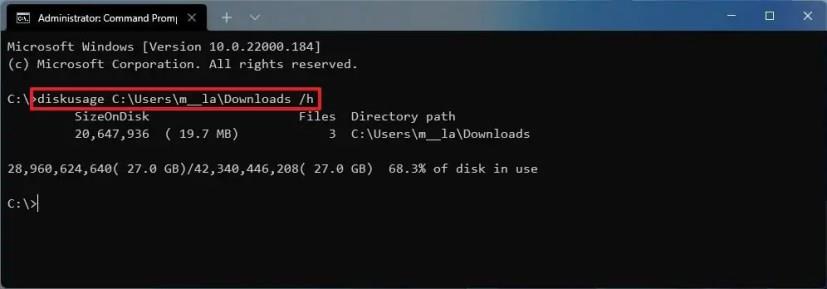
Uso de disco
A ferramenta inclui muitas opções para personalizar os detalhes do relatório. Por exemplo, o /minFileSizecomando pode ajudar a encontrar arquivos iguais ou maiores do tamanho que você especificou. O /ue /tpermitem que você veja os principais arquivos de um local específico e muitas outras opções.
Experiência pronta para uso (OOBE) redesenhada para Windows 11
O Windows 11 está apresentando uma nova experiência pronta para uso (OOBE) . Essa é a experiência pela qual você costuma passar para concluir a configuração inicial do sistema operacional com uma nova conta, configurações de privacidade e preferências personalizadas ao configurar um novo dispositivo ou após uma instalação limpa.
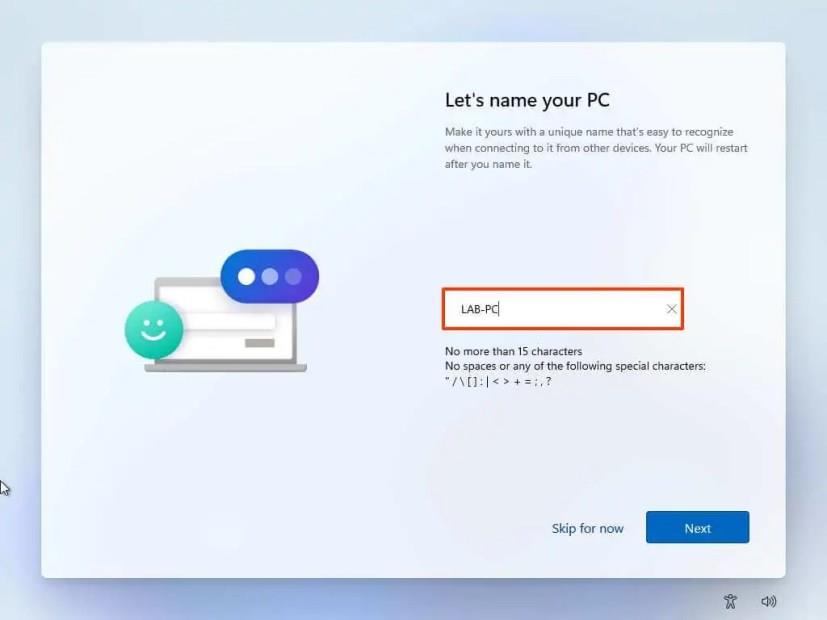
Windows 11 OOBE
A nova experiência se afasta das cores azul e escura em favor das cores branca e cinza com uma interface mais intuitiva e amigável para combinar com a nova linguagem de design moderna do Windows 11.
Você também encontrará novas animações à medida que avança em cada página. A Microsoft está até adicionando uma opção para definir o nome do computador à medida que você conclui a configuração nesta nova versão. A opção de criar uma conta online agora está enterrada na página “Opções de login” e, ao configurar o Windows 11 Home, os usuários precisarão ter uma conexão com a Internet e serão forçados a criar uma conta com uma conta da Microsoft . No entanto, há uma solução alternativa para ignorar o requisito e continuar com uma conta offline.
Aplicativos internos do Windows 11 redesenhados e novos
Como parte da nova revisão do Windows 11, a Microsoft também está atualizando muitos de seus aplicativos de caixa de entrada, como a Microsoft Store, Paint, Calculator, Clock, Tips e Snipping Tool, e apresentando mais alguns aplicativos novos, como Power Automate e Chat from Equipes da Microsoft.
Microsoft Store
Talvez uma das maiores melhorias no Windows 11 seja a adição do novo aplicativo da Microsoft Store. O app foi redesenhado com nova interface e animações, facilitando a busca e descoberta de conteúdo. Ao abrir o aplicativo pela primeira vez, você notará que a caixa de pesquisa está centralizada na parte superior e a navegação agora aparece no lado esquerdo.
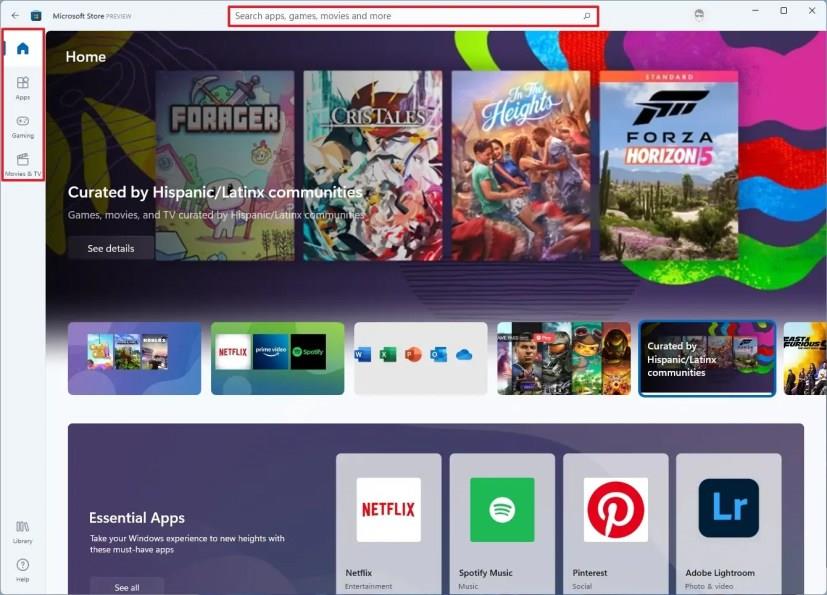
IU da Microsoft Store
Você ainda tem a maioria das mesmas categorias, incluindo Casa, Jogos, Filmes e TV, Biblioteca e Ajuda, mas a guia Oferta desapareceu.
A página do produto para aplicativos também foi atualizada com um novo layout que facilita o download e a instalação do lado esquerdo, enquanto as páginas de jogos, filmes e programas incluirão uma orientação vertical.
A guia "Biblioteca" é onde você pode verificar se há atualizações. Nesta seção, você também encontrará uma lista de todos os aplicativos e outros conteúdos que possui em todos os dispositivos.
Por fim, a Microsoft Store agora permitirá que os desenvolvedores disponibilizem qualquer tipo de aplicativo, incluindo os tradicionais Win32, .NET e aplicativos da web. Além disso, os desenvolvedores agora têm a opção de trazer sua própria plataforma de monetização para manter toda a receita, mas a opção de usar o serviço de comércio da Microsoft ainda estará disponível.
Iniciar
Nesta nova versão, o Get Started é um novo aplicativo para ajudar os iniciantes a se prepararem rapidamente. O aplicativo é básico e mostra coisas como começar a usar o Explorador de Arquivos, baixar aplicativos, navegar na interface e passar por alguns recursos básicos.
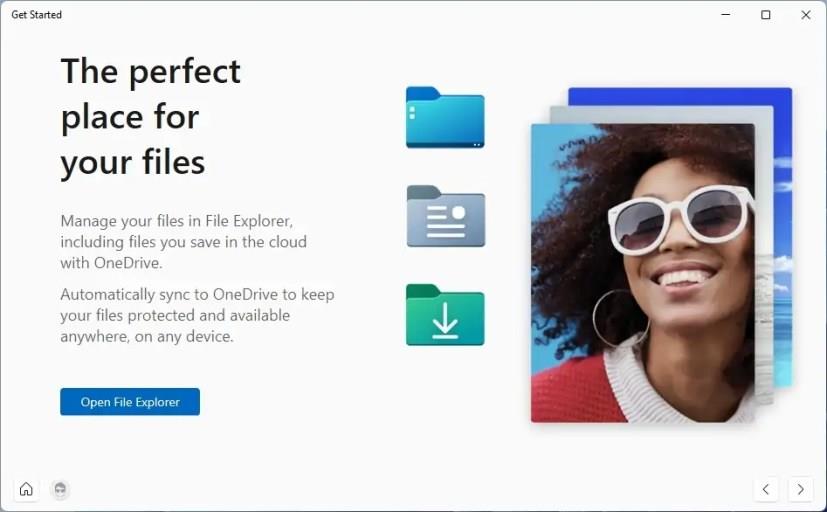
Aplicativo de introdução ao Windows 11
Pontas
O aplicativo Dicas também foi atualizado e é um aplicativo semelhante a Introdução, mas inclui dicas para saber mais sobre como usar o Windows 11. O aplicativo estava disponível em versões anteriores, mas agora oferece uma interface que corresponde à nova linguagem de design e apresenta mais de cem novas dicas.

Aplicativo de dicas do Windows 11
Calculadora
O aplicativo Calculadora também está recebendo uma atualização. A nova versão foi reescrita em C# e apresenta um novo visual que segue a nova linguagem de design da Microsoft com cantos arredondados e novos materiais.
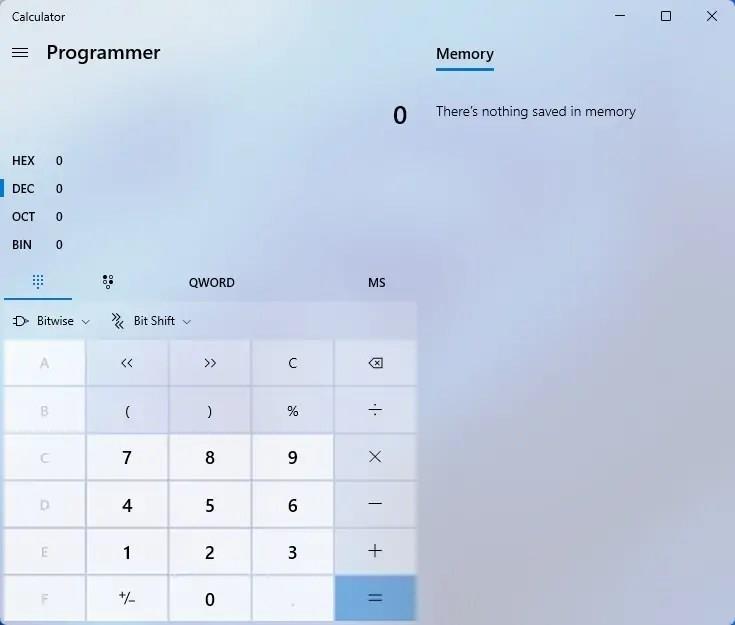
Aplicativo Calculadora do Windows 11
A empresa se concentrou em tornar o aplicativo simples para a calculadora padrão e a poderosa calculadora científica nesta versão.
Além disso, o Modo Programador oferece funcionalidades ricas que são essenciais para programação e engenharia. Plote uma ou mais equações no modo gráfico e, em seguida, analise o gráfico para ajudar a identificar os principais recursos do gráfico, como as interceptações “x-” e “y-”. E agora você pode converter em mais de 100 unidades e moedas diferentes.
Relógio
No Windows 11, o aplicativo “Alarmes e Relógio” passa a ser apenas “Relógio” e, junto com o novo nome, o aplicativo ganha uma nova interface com cantos arredondados e materiais semitransparentes. Além disso, esta nova versão vem com Focus Sessions, que pretende ser uma nova maneira de os usuários se concentrarem nas tarefas e no trabalho.
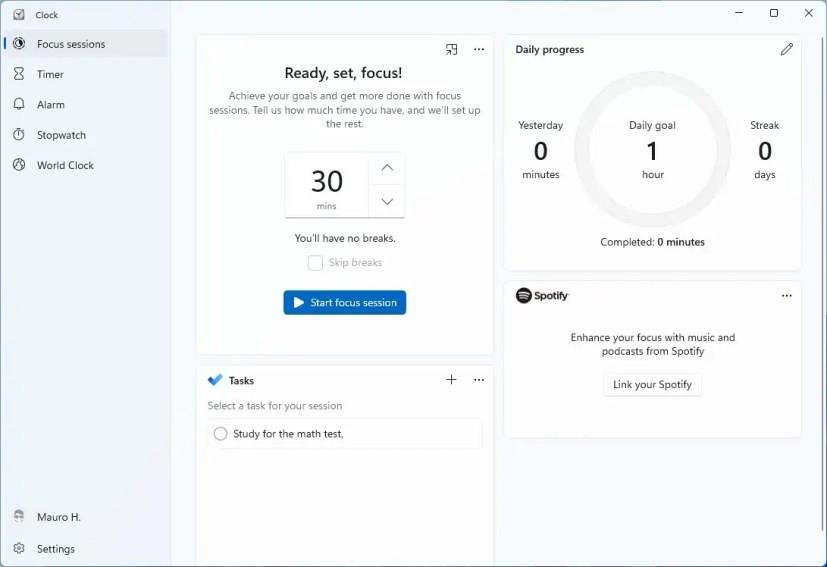
Relógio com sessões de foco
O Focus Sessions se integra ao Spotify, permitindo que você crie sessões enquanto reproduz sua lista de reprodução de música favorita para se concentrar e fazer o trabalho.
Do jeito que funciona, você abre o aplicativo Alarms & Clock e seleciona as Focus Sessions no painel esquerdo. Em seguida, você escolheria uma tarefa “Microsoft To-Do”, selecionaria uma lista de reprodução do Spotify, definiria o cronômetro e clicaria no botão “Iniciar sessão de foco”.
Além disso, dependendo do intervalo de tempo selecionado, você terá várias pausas automáticas e todas as suas sessões de foco serão rastreadas na seção “Progresso diário” no lado direito.
Fotos
O novo aplicativo Fotos possui uma interface moderna que segue a mesma linguagem de design que a empresa está promovendo com o sistema operacional usando o WinUI.
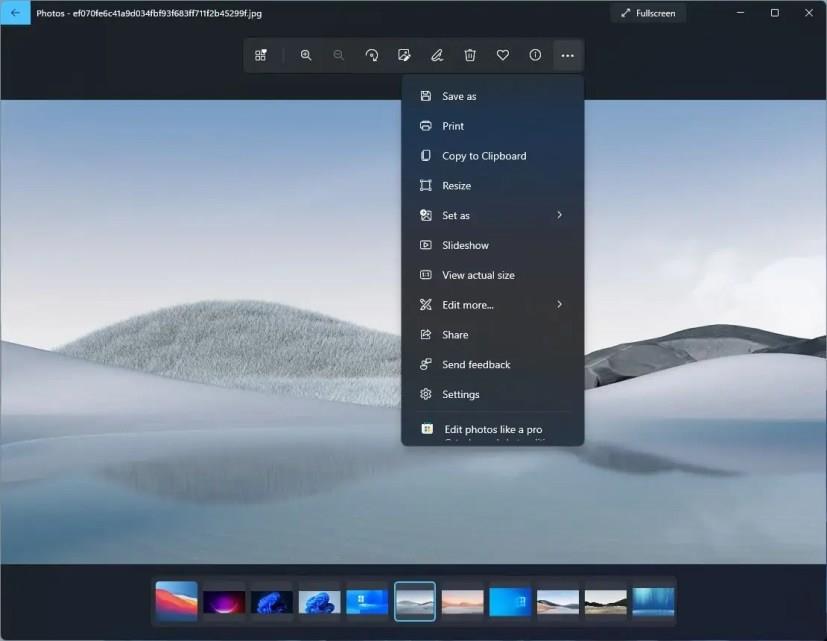
Aplicativo Fotos do Windows 11
O aplicativo mantém a mesma aparência clássica, mas inclui alterações que facilitam para os usuários organizar e editar suas fotos.
“Fotos” ainda tem as mesmas cinco categorias: Coleção, Álbuns, Pessoas, Pasta e Editor de Vídeo. A seleção de uma imagem agora será aberta, levando toda a tela do aplicativo, e os elementos flutuantes darão acesso aos comandos. E a bandeja inferior exibirá imagens adicionais que você pode selecionar para visualizar e editar um grupo de imagens.
A barra de comandos agora inclui uma ferramenta de “Marcação” que permite anotar a imagem.
Ferramenta de recorte
Em vez de remover o aplicativo herdado, a Microsoft está combinando o aplicativo Snip & Sketch moderno com a Ferramenta de Recorte herdada para criar um novo aplicativo único para fazer capturas de tela no Windows 11 .
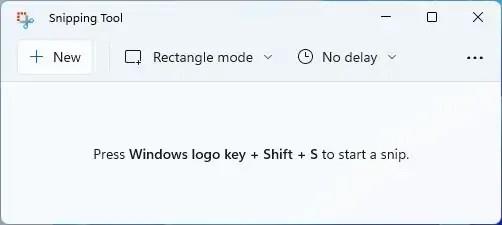
Aplicativo Ferramenta de Recorte do Windows 11
A nova Ferramenta de Recorte mantém a mesma aparência familiar da versão herdada, mas a interface foi modernizada para seguir a linguagem de design visual do Windows.
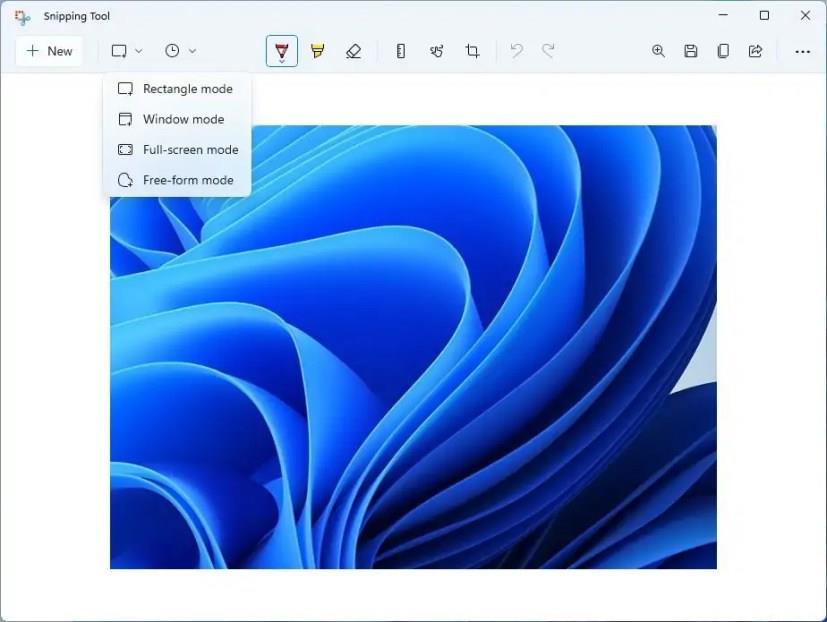
Editor de ferramentas de recorte
Além disso, o aplicativo traz os melhores recursos disponíveis no aplicativo Snip & Sketch. Por exemplo, ao abrir o novo aplicativo, você obterá o mesmo design familiar, mas com elementos visuais do Windows 11 e, ao fazer uma captura de tela, obterá as ferramentas Snip & Sketch para editar e anotar a captura de tela.
Correio e Calendário
O Windows 11 inclui novos aplicativos de email e calendário . Os novos aplicativos integram apenas cantos arredondados e outros ajustes visuais, mas permanecem praticamente os mesmos das versões anteriores.
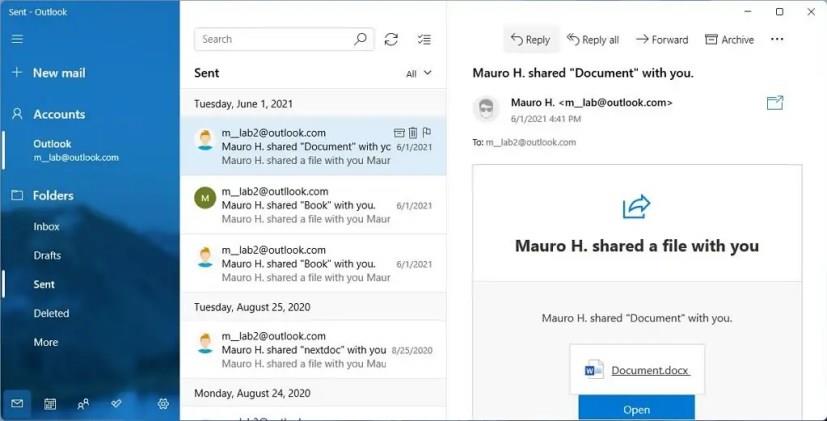
Aplicativo de email para Windows 11
Bate-papo do Microsoft Teams
A Microsoft também está integrando o Teams ao Windows 11, mas esta não é a versão completa. Em vez disso, o recurso é conhecido como Bate-papo do Microsoft Teams .
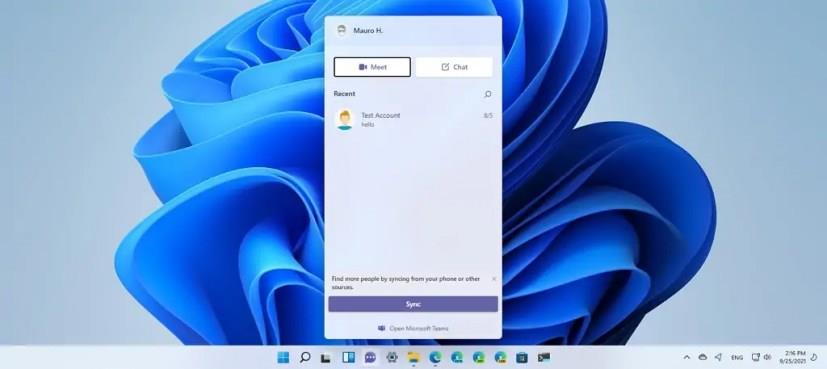
Bate-papo para equipes da Microsoft
O recurso permite que você faça chamadas de áudio e vídeo individuais ou em grupo. Você pode criar e participar de reuniões. Você pode ligar ou desligar o microfone e a câmera. Você pode escolher os alto-falantes, microfone e câmera preferidos. Você pode compartilhar sua tela. Você pode gerenciar as configurações das reuniões, visualizar a lista de participantes, admitir participantes da reunião no lobby, conversar e ver os vídeos das pessoas em uma exibição de galeria.
O recurso está convenientemente disponível na barra de tarefas e você pode se conectar a uma, independentemente da plataforma, incluindo Windows, iOS ou Android.
Automatização de energia
O Power Automate é um novo aplicativo que permite automatizar aplicativos da Web e da área de trabalho imitando as ações da interface do usuário, como cliques e entrada do teclado, para automatizar tarefas repetitivas.
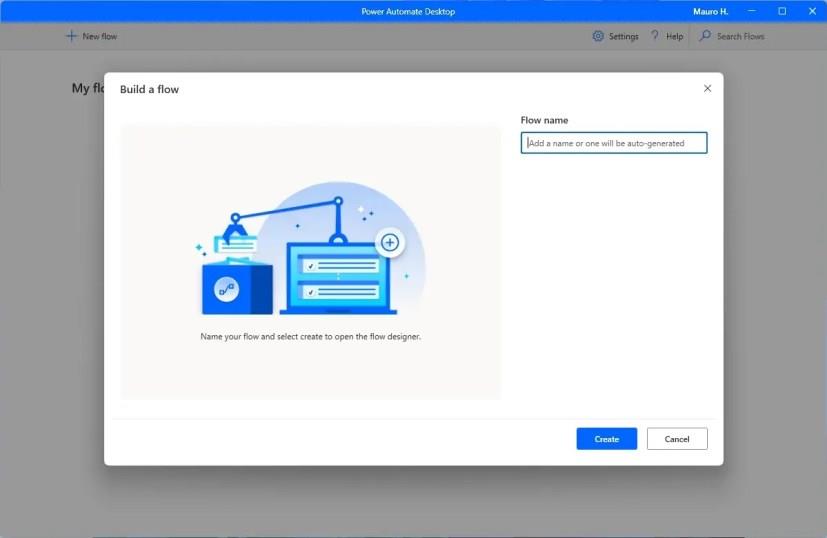
Aplicativo Windows 11 Power Automate
Conclusão
No geral, o Windows 11 é um ótimo novo sistema operacional que apresenta um aumento de interface muito necessário e oferece muitos novos recursos e melhorias. A versão mais recente parece muito estável e, como é baseada no Windows 10, a maioria dos drivers e aplicativos deve funcionar apenas nesta nova versão.
No entanto, existem algumas ressalvas com esta versão. Por exemplo, você ainda encontrará muitas inconsistências de interface ao longo da experiência, como menus e elementos que não foram atualizados para a nova linguagem de design. Além disso, ainda existem muitas ferramentas legadas que permanecem presentes, como o Painel de Controle e outras que não foram atualizadas, como o Gerenciador de Tarefas e o Gerenciador de Dispositivos.
Ao navegar e executar tarefas, o Windows parece mais rápido e estável, mas ainda há muitos bugs de design ou coisas incompletas. Além disso, durante a fase de lançamento inicial, muitos recursos, como suporte para aplicativos Android, não farão parte do Windows 11.
Um dos problemas significativos com esta versão é o aumento dos requisitos do sistema que exigem processadores e recursos de segurança significativamente mais novos, como TPM 2.0 e Secure Boot , que deixarão muitos computadores em bom funcionamento sem a chance de atualização.
Ao considerar todos os bons e maus, o Windows 11 recebe 3,5 estrelas de 5 para classificação .
A atualização do Windows 11 KB5007262 traz novos emojis 2D em vez do estilo 3D originalmente prometido. Veja como obtê-los.
Pesquisador de segurança divulga vulnerabilidade de dia zero no Windows 11 devido ao baixo pagamento da Microsoft em seu programa de recompensas de bugs.
O evento do Windows 11 começa às 11h ET / 8h PT em 24 de junho e você poderá assisti-lo ao vivo neste site da Microsoft.
A Microsoft planeja sediar um evento de trabalho híbrido em 5 de abril para mostrar os novos recursos do Windows 11 e vender o sistema operacional para clientes comerciais.
Windows 11 para mostrar os requisitos do sistema não atendidos. Vá para Configurações para saber mais sobre a marca d'água em um hardware compatível, mas você pode removê-la.
A Microsoft trará otimizações para jogos em janela e o novo aplicativo Windows HDR Calibration para melhorar a experiência de jogo do Windows 11.
Baixe os papéis de parede do Windows 365 para defini-los como plano de fundo da área de trabalho no Windows 11 ou 10. Detalhes aqui.
A área de transferência inteligente do Windows 11 pode chegar em breve ao Dev Channel para testar novas maneiras de copiar e colar da área de transferência.
O Windows 11 está atualizando o submenu Configurações rápidas com uma nova interface do usuário Bluetooth para alternar, conectar e desconectar dispositivos facilmente.
Agora você pode comprar uma cópia física do Windows 11 Home ou Pro em sua loja de varejo local. A caixa inclui uma mídia USB e uma chave de produto.
O Windows 11 tem um problema que faz com que as unidades NVMe mais lentas tenham um desempenho mais lento do que no Windows 10, e a Microsoft ainda não confirmou e corrigiu o problema.
Primeiro, veja a nova experiência de instalação do Windows 11, incluindo uma interface de usuário totalmente nova para a experiência pronta para uso (OOBE).
O Windows 11 vaza na web confirmando o nome oficial e revelando a nova interface e iconografia moderna.
O Windows 11 (21H2) foi designado para ampla implantação, o que significa que agora está disponível para todos os computadores compatíveis.
A barra de tarefas no Windows 11 está sendo arrastada e solta na próxima atualização de recursos após muitos comentários dos usuários.
O aplicativo Configurações para Windows 11 pode estar recebendo novos controles de herói e lembretes de requisitos para dispositivos sem suporte.
A barra de tarefas do Windows 11 agora pode mostrar notificações dinâmicas (tempo, esportes, finanças, notícias de última hora) nos ícones de widgets. Detalhes aqui.
O Windows 11 é a próxima maior versão do sistema operacional da Microsoft e aqui estão os recursos e alterações esperados e a data de lançamento.
Novos gestos de toque estão chegando ao Windows 11, incluindo gesto para navegar no menu Iniciar, Configurações rápidas, animações e garra.
O Windows 11 Pro agora exigirá uma conta da Microsoft para configurar um novo dispositivo ou instalação limpa, removendo a opção de criar uma conta local.
Quer dar um novo começo ao seu perfil do Twitch? Veja como alterar o nome de usuário e o nome de exibição do Twitch com facilidade.
Descubra como alterar o plano de fundo no Microsoft Teams para tornar suas videoconferências mais envolventes e personalizadas.
Não consigo acessar o ChatGPT devido a problemas de login? Aqui estão todos os motivos pelos quais isso acontece, juntamente com 8 maneiras de consertar o login do ChatGPT que não funciona.
Você experimenta picos altos de ping e latência no Valorant? Confira nosso guia e descubra como corrigir problemas de ping alto e atraso no Valorant.
Deseja manter seu aplicativo do YouTube bloqueado e evitar olhares curiosos? Leia isto para saber como colocar uma senha no aplicativo do YouTube.
Descubra como bloquear e desbloquear contatos no Microsoft Teams e explore alternativas para um ambiente de trabalho mais limpo.
Você pode facilmente impedir que alguém entre em contato com você no Messenger. Leia nosso guia dedicado para saber mais sobre as implicações de restringir qualquer contato no Facebook.
Aprenda como cortar sua imagem em formatos incríveis no Canva, incluindo círculo, coração e muito mais. Veja o passo a passo para mobile e desktop.
Obtendo o erro “Ação bloqueada no Instagram”? Consulte este guia passo a passo para remover esta ação foi bloqueada no Instagram usando alguns truques simples!
Descubra como verificar quem viu seus vídeos no Facebook Live e explore as métricas de desempenho com dicas valiosas e atualizadas.
